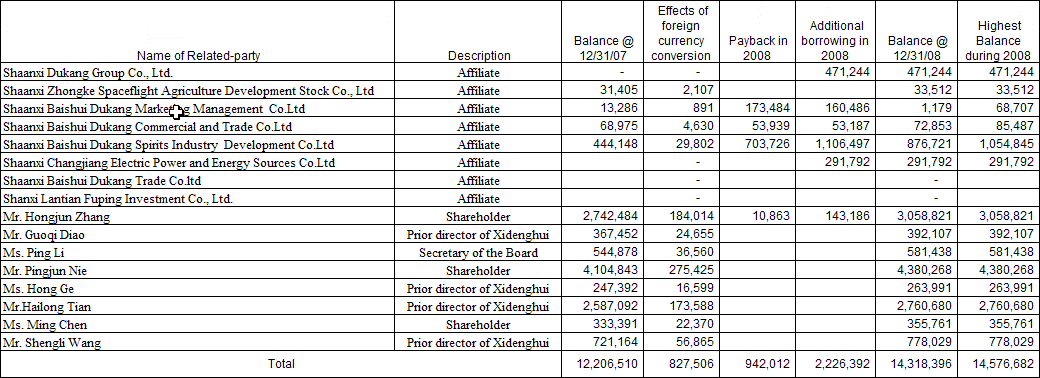U.S. Securities and Exchange Commission
Washington, D.C. 20549
FORM 10-K
| |
[X] | Annual Report Under Section 13 or 15(d) of The Securities Exchange Act of 1934 for the Fiscal Year Ended December 31, 2009 |
| |
[ ] | Transition Report Under Section 13 or 15(d) of The Securities Exchange Act of 1934 for the Transition Period from _______ to _______ |
Commission File Number: __________
CHINA DU KANG CO., LTD
(Exact name of small business issuer as specified in its charter)
| |
Nevada | 90-0531621 |
(State or other jurisdiction of | (IRS Employer Identification No.) |
incorporation or organization) | |
Town of Dukang, Baishui County,
A-28,Van Metropolis,#35 Tangyan Road,
Xi'an, Shaanxi, PRC, 710065
(Address of principal executive offices)
8629-88830106-822
(Issuer's telephone number)
Securities registered under Section 12(b) of the Act:
| | |
Title of each class | | Name of each exchange on which registered |
| | |
None | | Not Applicable |
Securities registered under Section 12(g) of the Exchange Act:
Common Stock, $.001 par value
(Title of Class)
Indicate by check mark whether the registrant (1) has filed all reports required to be filed by Section 13 or 15(d) of the Exchange Act during the past 12 months (or for such shorter period that the registrant was required to file such reports), and (2) has been subject to such filing requirements for the past 90 days.
Yes [x] No [ ]
Indicate by check mark if disclosure of delinquent filers pursuant to Item 405 if Regulation S-K (229.405 of this Chapter) is not contained herein, and will not be contained, to the best of the registrant’s knowledge, in definitive proxy of information statements incorporated by reference in Part III of this Form 10-K or any amendments to this Form 10-K.
Yes [ ] No [x]
Indicate by check mark whether the registrant is a large accelerated filer, an accelerated filer, a non-accelerated filer, or a smaller reporting company. See definitions of “large accelerated filer”, “accelerated filer” and “smaller reporting company” in Rule 12b-2 of the Exchange Act.
| |
Large accelerated filer | o |
Non-accelerated filer | o(Do not check if a smaller reporting company) |
Accelerated filer | o |
Smaller reporting company | X |
Indicate by check mark whether the registrant is a shell company (as defined in rule 12b-2 of the exchange act).
Yes [ ] No [X]
The Registrant’s revenues for its fiscal year ended December 31, 2009 were $1,987,659.
The aggregate market value of the voting stock on April 1, 2009 (consisting of Common Stock, $0.001 par value per share) held by non-affiliates was approximately $10,450,054 based upon the most recent sales price for such Common Stock on said date ($0.12) April 1, 2009, there were 100,113,791 shares of our Common Stock issued and outstanding, of which approximately 87,083,791 shares were held by non-affiliates.
Number of shares of common stock, par value $.001, outstanding as of April 1, 2009: 100,113,791
2
Table of Contents
DOCUMENTS INCORPORATED BY REFERENCE
None
CAUTIONARY STATEMENT REGARDING FORWARD LOOKING INFORMATION
The discussion contained in this 10-K under the Securities Exchange Act of 1934, as amended, contains forward-looking statements that involve risks and uncertainties. The issuer's actual results could differ significantly from those discussed herein. These include statements about our expectations, beliefs, intentions or strategies for the future, which we indicate by words or phrases such as "anticipate," "expect," "intend," "plan," "will," "we believe," "the Company believes," "management believes" and similar language, including those set forth in the discussions under "Notes to Financial Statements" and "Management's Discussion and Analysis or Plan of Operation" as well as those discussed elsewhere in this Form 10-K. We base our forward-looking statements on information currently available to us, and we assume no obligation to update them. Statements contained in this Form 10-K that are not historical facts are forward-looking statements that are subject to the "safe harbor" created by the Private Securities Litigation Reform Act of 1995.
3
TABLE OF CONTENTS
| | |
PART I: | | |
| | 5 |
Item 1. | Business | 10 |
Item 1A. | Risk Factors | 17 |
Item 1B. | Unresolved Staff Comments | 17 |
Item 2. | Properties | 20 |
Item 3 | Legal Proceedings | 21 |
Item 4. | Submission of Matters to a Vote of Security Holders | 21 |
| | |
PART II: | | |
| | |
Item 5. | Market for Registrant’s Common Equity, Related Stockholder Matters and Issuer Purchases of Equity Securities | 21 |
Item 6. | Selected Financial Data | 23 |
Item 7. | Management’s Discussion and Analysis of Financial Condition and Results of Operations | 23 |
Item 7A. | Quantitative and Qualitative Disclosures About Market Risk | 35 |
Item 8. | Financial Statements and Supplementary Data | 36 |
Item 9. | Changes in and Disagreements with Accountants on Accounting and Financial Disclosure | 70 |
Item 9A. | Controls and Procedures | 70 |
Item 9A(T). | Controls and Procedures | 70 |
Item 9B. | Other Information | 70 |
| | |
PART III: | | |
| | |
Item 10. | Directors, Executive Officers and Corporate Governance | 70 |
Item 11. | Executive Compensation | 72 |
Item 12. | Security Ownership of Certain Beneficial Owners and Management and Related Stockholder Matters | 73 |
Item 13. | Certain Relationships and Related Transactions, and Director Independence | 74 |
Item 14. | Principal Accounting Fees and Services | 75 |
| | |
PART IV: | | |
| | |
Item 15. | Exhibits, Financial Statement Schedules | 76 |
| | |
SIGNATURES: | | 77 |
ITEM 1. BUSINESS
China Du Kang Co., Ltd (“Du Kang” or the “Company”) was incorporated as U. S. Power Systems, Inc., in the State of Nevada on January 16, 1987. On or about June 8, 2006 the Company’s name was changed to Premier Organic Farms Group, Inc. On or about November 30, 2006 the name was changed to Amstar Financial Holdings, Inc. (“AFLH”). On or about March 18, 2008 the name was changed to its current name of China Du Kang Co., Ltd. with its corporate charter still residing in Nevada. The Company changed its fiscal year ending from September 30 to December 31 in February 2008.
Overview
The Company had been engaged in the business to provide various financial services since it's incorporation. The Company was not successful and discontinued the majority of its operation by December 31, 2007.
“We previously were a shell company, therefore the exemption offered pursuant to Rule 144 is not available. Anyone who purchased securities directly or indirectly from us or any of our affiliates in a transaction or chain of transactions not involving a public offering cannot sell such securities in an open market transaction.”
On January 10, 2008, the Company entered into a Plan of Exchange Agreement (the “Agreement”) with Hong Kong Merit Enterprise Limited (“Merit”), a holding company incorporated in Hong Kong. Pursuant to the terms of the Agreement, the Company agreed to issue post split 88,000,000 shares of its common stock to the shareholder(s) of Merit in exchange for Merit to transfer all of its issued and outstanding shares of common stock to the Company, thereby causing Merit to become a wholly-owned subsidiary of the Company. Merit also agreed to pay $260,000 to the Company at closing. The parties closed the transaction contemplated by the Agreement on February 11, 2008.
This transaction is being accounted for as a reverse merger, since the shareholders of Merit owns a majority of the outstanding shares of the Company’s common stock immediately following the share exchange. Merit is deemed to be the acquirer in the reverse merger. Consequently, the assets and liabilities and the historical operations that will reflected in the consolidated financial statements for periods prior to the share exchange will be those of Merit and its subsidiaries and will be recorded at the historical cost basis. After completion of the share exchange, the Company‘s consolidated financial statements will include the assets and liabilities of both Du Kang and Merit, the historical operations of Merit and the operations of the Company and its subsidiaries from the closing date of the share exchange.
Merit was incorporated on September 8, 2006 in Hong Kong under the Companies Ordinances as a Limited Liability company. Merit was formed for the purpose of seeking and consummating a merger or acquisition with a business entity organized as a private corporation, partnership, or sole proprietorship.
On January 22, 2008, Merit entered into a Share Purchase Agreement (the “Purchase Agreement”) with the owners of Shaanxi Huitong Food Co., Inc. ("Huitong"), a limited liability company incorporated in the People's Republic of China ("PRC") on August 9, 2007 with a registered capital of $128,200 (RMB1,000,000). Pursuant to the Purchase Agreement, the Merit agreed to purchase 100% of the equity ownership in Huitong for a cash consideration of
$136,722 (RMB 1,000,000). Subsequent to the completion of the Agreement, Huitong became a wholly-owned subsidiary of Merit.
Huitong was formed for the purpose of seeking and consummating a merger or acquisition with a business entity organized as a private corporation, partnership, or sole proprietorship. On December 26, 2007 Huitong executed a share exchange agreement (the "Exchange Agreement") with the owners of Shaanxi Xidenghui Technology Stock Co., Ltd. ("Xidenghui"), whereby Huitong exchanged 100% of its issued and outstanding capital for 98.24% of the equity ownership in Xidenghui. Subsequent to completion of the Share Exchange, Xidenghui became a majority-owned subsidiary of Huitong.
Xidenghui was incorporated in Weinan City, Shaanxi Province, PRC on March 29, 2001 under the Company Law of PRC. Xidenghui was engaged in the business of production and distribution of distilled spirit with a brand name of “Xidenghui”. Currently, its principal business is to hold an equity ownership interest in Shannxi Baishui Dukang Liquor Co., Ltd. (“Baishui Dukang”) and Shaanxi Baishui Dukang Liquor Brand Management Co., Ltd. (“Brand Management”).
Baishui Dukang was incorporated in Baishui County, Shaanxi Province, PRC on March 1, 2002 under the Company Law of PRC. Baishui Dukang was principally engaged in the business of production and distribution of distilled spirit with a brand name of “Baishui Dukang”. On May 15, 2002, Xidenghui invested inventory and fixed assets, with a total fair value of $ 4,470,219 (RMB 37,000,000) to Baishui Dukang and owns 90.51% of Baishui Dukang’s equity interest ownership, thereby causing Baishui Dukang to become a majority-owned subsidiary of Xidenghui.
On October 30, 2007, Xidenghui executed an agreement with Mr. Zhang Hongjun, a PRC citizen, to establish a joint venture, Shaanxi Baishui Dukang Liquor Brand Management Co., Ltd. ("Brand Management"). Pursuant to the agreement, Xidenghui contributed cash of $769,200 (RMB 700,000), and owns 70% equity interest ownership therein. Brand Management was subsequently incorporated on November 12, 2007. Upon the completion of incorporation, Brand Management became a majority-owned subsidiary of the Xidenghui. Xidenghui is principally engaged in the business of distribution of Baishui Dukang’s liquor and manage the franchise of the “Baishui Dukang” brand name.
Baishui Dukang and Brand Management are the two of these affiliated companies that are engaged in business operations. Du Kang, Merit, Huitong, and Xidenghui are holding companies, whose business is to hold an equity ownership interest in Baishui Dukang and Brand Management. All these affiliated companies are hereafter referred to as the "Company". Currently, the Company is principally engaged in the business of production and distribution of distilled spirit with the brand name of “Baishui Dukang”. The Company also franchises the brand name to other liquor productors. The Company's structure is summarized in the flow chart found in Item 14. Supplementary Data.
Previous to this, on or about October 25, 2006 a Definitive Agreement was entered into by Premier Organic Farms Group, Inc. and Amstar International, Inc. On or about December 19, 2006, the merger defined in this agreement was closed. In the definitive agreement Amstar International, Inc. was to merge with Premier Organic Farms Group, Inc. (PFOG). Prior to the merger PFOG was to change its name to Amstar Financial Holdings, inc., dilute their shares down to approximately 608,771 shares with 96.12% of the ownership passing to Amstar International Stockholders. In addition, as part of the terms of this agreement a favorable hearing before a judge of competent jurisdiction, regarding a petition of fairness subject to section 3(a)(10) of the Securities Act of 1933 was to be approved. An order granting this petition of fairness was signed on December 18, 2006 by a judge in State of Nevada, County of Elko, case number CV- C-06-1016. This transaction closed on December 19, 2006, in Phoenix, Arizona.
6
Current Operations
Shaanxi Xi Deng Hui Technology Stock Co. Ltd. is holding company which established on March 29, 2001 after being restructured enterprise with added capital. The registered capital is 129,000,000 RMB ($17,793,103 USD). On or about January 31, 2008 Shaanxi Xi Deng Hui Technology Stock Co. Ltd purchased a majority interest in Amstar Financial Holdings, Inc. (formerly AFLH) in a reverse merger. The company’s new name is China Du Kang Company Limited now listed as CDKG.
Shaanxi Xi Deng Hui Stock Co. Ltd., Holds
l
90.51% and controls Shaanxi Bai Shui Du Kang Liquor Co., Ltd., and holds
l
70% Shaanxi Bai Shui Du Kang Brand Management Co., Ltd.;
Principal Products
The Company manufactures, sells, licenses and distributes a proprietary line of white wines that are generally known in China under the heading Du Kang. The largest sellers are currently collections called the “Baishui Dukang” series, the Thirteen Dynasties series and Jiu Zu Gong.
Du Kangis a generic description, like “vodka” or “merlot” and is one of the most famous Chinese white wine brands. The Company’s subsidiaries Shaanxi Bai Shui Du Kang Liquor Co. Ltd and Shaanxi Bai Shui Du Kang own the “Bai Shui Du Kang” brand, while another subsidiary, owns three 3 brands:
·
Bai Shui Du Kang
·
Thirteen Dynasties and
·
Jiu Zu Gong.
At present, Du Kang has 6000 ton production capacity per year including (brewing and packaging). Liquor products unit price ranges from $2.00 USD to $150.00 USD. Our Du Kang Liquor products are sold in most cities in China. In northeast, north, south coastal region and middle areas of China we sell liquor through long-term liquor distributors. In Shaanxi province we sell liquor to franchise stores in Xi’an ,Bai Shui, Hua yin, Han Cheng, Fu Ping Pu Cheng, Da Li, Wei Nan city. Throughout China the Du Kang market sales, awareness and brand image is broadening.
Through its subsidiaries in China, the Company sells and develops new and additional liquors, liquor raw materials, deep processing of agricultural and sideline products and research and develop of high-tech products and brewing methods. We were the first company, in cooperation with the Chinese Academy of Sciences, to ship Du Kang yeast and grain aboard #3 and #7 Shenzou spaceflights for a series of scientific experiements designed to improve yield and flavors. No newly developed products have entered the market since 2008. We are currently focusing on expanding distribution of existing brands so we have devoted only minimal resources to research and development activities in the past two years.
Major products include the Baishui Dukang series, Thirteen Dynasties series, Shen Zhou Nectar, Guo Bin Special, and Jiu Zu Gong.
Distribution methods of the products or services;
7
The company’s products were sold in the following three ways:
·
Sales within China by long-term liquor distributors.
·
Sales to franchise liquor stores/retailers and
·
Our holding company, Shaanxi Bai Shui Du Kang Brand Management Co., Ltd. gave the franchise of using “Baishui Dukang” trademark to make white spirits to manufactures who comply with the liquor (or white spirits) production standard of PRC.
We have implemented two strategies for retail sales of our producs. First, we have developed exclusive territorial “franchises” in different designated provinces of China – Shaanxi, Guangzdong,Zhejiang,Liaoning,Hunan, Heilongjiang, Shanghai, etc. Secondly, we have developed licensing agreements for the use of our trademarks. There are currently licensing agreements in An Hui and Shaanxi province.
The company signed a 5-year exclusive distributor contract with liquor distributors. Our major liquor distributors include Shaanxi Baishui Dukang Spirits Industry Development Co., Ltd. ,Shaanxi Baishui Dukang Liquor Group Co., Ltd. and Shaanxi Baishui Dukang Marketing Management Co., Ltd. respectively. The material terms are as follows:
1.During the contract term, Shaanxi Baishui Dukang Spirits Industry Development Co., Ltd. can only act as the distributor of the series products of Baishui Dukang, Thirteen Dynasties and Jiu Zu Gong in the designated provinces including Guangdong, Yunan, Fujian, Henan, Shandong and Hebei, and cannot act as a distributor in any other products of the third party.
2、 During the contract term, Shaanxi Baishui Dukang Marketing Management Co., Ltd. can only act as the distributor of the series products of Baishui Dukang and Thirteen Dynasties in the designated provinces including Shaanxi, Hunan, Gansu and Neimeng , and cannot act as a distributor in any other products of the third party.
3. During the contract term,Shaanxi Baishui Dukang Liquor Group Co., Ltd. can only act as the distributor of the series products of Baishui Dukang and Thirteen Dynasties in 5 designated provinces including Jiangsu,Zhejiang, Liaoning, Jiling and Heilongjiang, and cannot act as a distributor for any other third party’s products.
Du Kang set a new sales strategy, including sales territory that cover many counties in China and since July 2007. Du Kang Liquor products previously have been sold mostly in the larger cities in China. In 2008 and 2009, we put in place distributorship agreements in the form of franchises or licensing that now includes the northeast, north, south coastal region and middle areas of China. .
In the Shaanxi province we sell products to franchised stores in Xi’an Bai Shui, Hua yin, Han Cheng, Fu Ping,Pu Cheng, Da Li, and the city of Wei NanWe believe our distribution efforts have also raised market awareness and brand image of the Du Kang series.
Competitive Business Conditions
While management is pleased at the progress of the distribution of its Du Kang liquors, it remains a relatively insignificant participant in the liquor and beverage industry. We were recently awarded inclusion in China’s top 500 large and medium sized beverage manufacturers. An article in the April, 2009 edition ofThe Atlanticmagazine
reported that “Maotai”, a “baijiu” type of white liquor that is competitive, was the largest selling liquor in the world. The article notes that Maotai is somewhat expensive – the bottle tested cost $115 USD, smells of ammonia, and has a bitter taste.
A February, 2010 issue of China Daily also noted that"Moutai and Wuliangye”, two higher end liquors were selling briskly, The article quotedA report from China Jianyin Investment Securities that said,
“in 2010, China's high-end liquor (wine and spirit) consumption will grow by more than "30 percent" from a year earlier, higher than the liquor market as a whole, which will see a "20 to 25" percent rise..”
The Company believes that its Du Kang series is positioned well against the larger sellers and should enjoy increased sales if the liquor market overall improves as expected.
Sources and Availability of Raw Materials
The raw material needed in our production is mainly grain. The company purchases sorghum from farmers in the northeast and other wholesalers. While its price fluctuates in response to market conditions, availability has never been an issue. In addition, the company expects to enter into a contract of quota system for the production by local farmers to purchase some of the other required raw materials such as wheat and corn
Dependence of Major Customers
The company has long-term marketing contract with the following three companies: Shaanxi Baishui Dukang Wine Development Co., Ltd., Shaanxi Baishui Dukang Marketing Management Co., Ltd., Shaanxi Dukang Liquor Group Co., Ltd.. These three companies sell our products in China.
We have begun to expand our distributorship and licensing programs and expect to reduce the dependence on these three distributors over the course of 2010.
Patents, trademarks, licenses, franchises, concessions, royalty agreements or labor contracts, including duration;
The company has received all the certificates required to be issued by the Chinese government pertaining to production and sales of liquor, such as the Production License, Trade Mark Registration Certificate, etc. All these certificates are in force.
We believe we have full rights to the intellectual property required for sales in China. We have been contacted by a U. S. group that indicates that they have a prior right to the name “Du Kang” within the United States.
Regulation.
We are currently regulated People’s Government of Shaanxi Province approved Business License, Organization Code of PRC. We have obtained and maintain China Manufacture Certificate, Sanitation License and Food Security permits to issuer’s parent company in China, which we believe are all of the necessary legal government approvals if a manufacturer in PRC starts its business and continue its operation.
The greatest impact of government regulation for company’s business is the change of tax policy. In China, white spirit production belongs to a traditionally high tax industry. However, the company’s location, Bai Shui county, is rated as a national level poor county. The company is considered to be a pillar enterprise and major client of taxation in Bai Shui county.
Historically, the company has enjoyed preferential tax treatment on a national and local level. The Company entered into a Tax Abatement Agreement in 2004. Taxes were exempted for the first 2 years of existence of the Agreement
and reduced by half for the following 3 years. The Agreement expired as of August, 2009. Management is optimistic that they can work with taxing authorities to continue some level of preferential tax treatment for income of the company.
Costs and effects of compliance with environmental laws
The company’s manufacturing process meets the national standard for environmental protection. Moreover, the company was commended as a “Manufacturing Enterprise to Recycle Energy” by the government of the Shaanxi province.
ITEM 1 A.
RISK FACTORS
RISK FACTORS
RISKS RELATED TO OUR BUSINESS
OUR AUDITORS HAVE NOTED THERE IS CERTAIN DOUBT ABOUT OUR ABILITY TO OPERATE AS A GOING CONCERN
As reflected in the accompanying consolidated financial statements, the Company has an accumulated deficit of $17,436,438 at December 31, 2009 that includes losses of $597,872 and $1,591,791 for the years ended December 31, 2009 and 2008, respectively. In addition, The Company has a working capital deficiency of $13,431,548 and a shareholders' deficiency of $7,131,843 at December 31, 2009. These factors raise certain doubt about its ability to continue as a going concern.
Management has taken steps to revise the Company's operating and financial requirements. The Company is actively pursuing additional funding and a potential merger or acquisition candidate and strategic partners, which would enhance owners' investment. However, there can be no assurance that sufficient funds required during the next year or thereafter will be generated from operations or that funds will be available from external sources such as debt or equity financings or other potential sources. The lack of additional capital resulting from the inability to generate cash flow from operations or to raise capital from external sources would force the Company to substantially curtail or cease operations and would, therefore, have a material adverse effect on its business. Furthermore, there can be no assurance that any such required funds, if available, will be available on attractive terms or that they will not ha ve a significant dilutive effect on the Company's existing stockholders.
The accompanying financial statements do not include any adjustments related to the recoverability or classification of asset-carrying amounts or the amounts and classification of liabilities that may result should the Company be unable to continue as a going concern.
WE HAVE HAD LOSSES FROM OPERATIONS AND ANTICIPATE TO ACHIEVE PROFIT THROUGH THE INCOME AND DECREASE THE LOSSES FOR THE FORESEEABLE FUTURE.
10
Since inception we have had limited revenues from operation. Revenues for the year ended December 31, 2009 totaled $ 1,987,659 as compared to $1,143,195 for the year ended 2008. For the year ended December 31, 2009 we experienced a loss from operations of $(541,404) as compared to a loss of $(1,578,211) for the prior year..We have not achieved profitability. We expect to incur significant operating expenses and, as a result, will need to generate significant revenues to achieve profitability, which may not occur. Even if we do achieve profitability, we may be unable to sustain or increase profitability on an ongoing basis.
OUR CURRENT SHAREHOLDERS CONTROL OUR BUSINESS AFFAIRS IN WHICH CASE YOU WILL HAVE LITTLE OR NO PARTICIPATION IN OUR BUSINESS.
Our principal stockholders owns a majority of our common stock. As a result, they will have control over all matters requiring approval by our stockholders without the approval of minority stockholders. In addition, they will also be able to elect all of the members of our Board of Directors, which will allow they to control our affairs and management. They will also be able to affect most corporate matters requiring stockholder approval by written consent, without the need for a duly noticed and duly-held meeting of stockholders. As a result, they will have significant influence and control over all matters requiring approval by our stockholders. Accordingly, you will be limited in your ability to affect change in how we conduct our business.
WE MAY INCUR SIGNIFICANT COSTS TO ENSURE COMPLIANCE WITH CORPORATE GOVERNANCE AND ACCOUNTING REQUIREMENTS.
We expect to incur significant costs associated with our public company reporting requirements, costs associated with applicable corporate governance requirements, including requirements under the Sarbanes-Oxley Act of 2002 and other rules implemented by the SEC. We expect all of these applicable rules and regulations to increase our legal and financial compliance costs and to make some activities more time-consuming and costly. While we have no experience as a public company, we estimate that these additional costs will total approximately $60,000 per year. We also expect that these applicable rules and regulations may make it more difficult and more expensive for us to obtain director and officer liability insurance and we may be required to accept reduced policy limits and coverage or incur substantially higher costs to obtain the same or similar coverage. As a result, it may be more difficult for us to attract and retain q ualified individuals to serve on our board of directors or as executive officers. We are currently evaluating and monitoring developments with respect to these newly applicable rules, and we cannot predict or estimate the amount of additional costs we may incur or the timing of such costs.
RISKS RELATING TO OUR SECURITIES
WE HAVE NEVER PAID DIVIDENDS ON OUR COMMON STOCK AND YOU MAY NEVER RECEIVE DIVIDENDS. THERE IS A RISK THAT AN INVESTOR IN OUR COMPANY WILL NEVER SEE A RETURN ON INVESTMENT AND THE STOCK MAY BECOME WORTHLESS.
11
We have never paid dividends on our common stock. We intend to retain earnings, if any, to finance the development and expansion of our business. Future dividend policy will be at the discretion of the Board of Directors and will be contingent upon future earnings, if any, our financial condition, capital requirements, general business conditions and other factors. Future dividends may also be affected by covenants contained in loan or other financing documents, which may be executed by us in the future. Therefore, there can be no assurance that cash dividends of any kind will ever be paid. If you are counting on a return on your investment in the common stock, the shares are a risky investment.
THERE IS CURRENTLY NO SUBSTANTIAL MARKET FOR OUR COMMON STOCK AND NO ASSURANCE THAT ONE WILL DEVELOP.
There is currently on an extremely limited trading market for our shares of Common Stock, under the symbol “CDKG.” We have provided no public information and our symbol contains a “skull and crossbones” insignia on the pink sheets. We are filing this information partly to provide such information to the public although there can be no assurance that a more substantial market will ever develop or be maintained. Any market price for shares of our Common Stock is likely to be very volatile, and numerous factors beyond our control may have a significant adverse effect. In addition, the stock markets generally have experienced, and continue to experience, extreme price and volume fluctuations which have affected the market price of many small capital companies and which have often been unrelated to the operating performance of these companies. These broad market fluctuations, as well as general economic a nd political conditions, may also adversely affect the market price of our Common Stock. Further, there is no correlation between the present limited market price of our Common Stock and our revenues, book value, assets or other established criteria of value. The present limited quotations of our Common Stock should not be considered indicative of the actual value of the Company or our Common Stock.
Future sales of our common stock could put downward selling pressure on our shares, and adversely affect the stock price. There is a risk that this downward pressure may make it impossible for an investor to sell his shares at any reasonable price.
Future sales of substantial amounts of our common stock in the public market, or the perception that such sales could occur, could put downward selling pressure on our shares, and adversely affect the market price of our common stock. Such sales could be made pursuant to Rule 144 under the Securities Act of 1933, as amended, as shares become eligible for sale under the Rule.
BECAUSE OUR SHARES ARE DEEMED HIGH RISK “PENNY STOCKS,” YOU MAY HAVE DIFFICULTY SELLING THEM IN THE SECONDARY TRADING MARKET.
The Commission has adopted regulations which generally define a "penny stock" to be any equity security that has a market price (as therein defined) less than $5.00 per share or with an exercise price of less than $5.00 per share, subject to certain exceptions. Additionally, if the equity security is not registered or authorized on a national securities exchange, the equity security also constitutes a "penny stock." As our common stock falls within the definition of penny stock, these regulations require the delivery, prior to any transaction involving our common stock, of a risk disclosure schedule explaining the penny stock market and the risks associated with it. These regulations generally require broker-dealers who sell penny stocks to persons other than established customers and accredited investors to deliver a disclosure schedule explaining the penny stock market and the risks associated with that market. Disc losure is also required to be made about compensation payable to both the broker-dealer and the
registered representative and current quotations for the securities. These regulations also impose various sales practice requirements on broker-dealers. In addition, monthly statements are required to be sent disclosing recent price information for the penny stocks. The ability of broker/dealers to sell our common stock and the ability of shareholders to sell our common stock in the secondary market is limited. As a result, the market liquidity for our common stock is severely and adversely affected. We can provide no assurance that trading in our common stock will not be subject to these or other regulations in the future, which would negatively affect the market for our common stock.
IF A MARKET DEVELOPS FOR OUR SECURITIES THE COULD BE VOLATILE AND MAY NOT APPRECIATE IN VALUE.
If a market should develop for our securities, of which we have no assurance, the market price is likely to fluctuate significantly. Fluctuations could be rapid and severe and may provide investors little opportunity to react. Factors such as changes in results from our operations, and a variety of other factors, many of which are beyond the control of the Company, could cause the of our common stock to fluctuate substantially. Also, stock markets in penny stock shares tend to have extreme price and volume volatility. The market prices of shares of many smaller public companies securities are subject to volatility for reasons that frequently unrelated to the actual operating performance, earnings or other recognized measurements of value. This volatility may cause declines including very sudden and sharp declines in the market price of our common stock. We cannot assure investors that the stock price will appreciate in value, that a market will be available to resell your securities or that the shares will retain any value at all.
RISKS RELATING TO DOING BUSINESS IN THE PEOPLE'S REPUBLIC OF CHINA
WE ARE SUBJECT TO THE POLITICAL AND ECONOMIC POLICIES OF THE PEOPLES REPUBLIC OF CHINA, AND GOVERNMENT REGULATION COULD HAVE A MATERIAL ADVERSE EFFECT ON OUR INTENDED BUSINESS.
All of our assets and operations are in the PRC. As a result our operating results and financial performance as well as the value of our securities could be affected by any changes in economic, political and social conditions in China.
The Chinese government adopted an “open door” policy to transition from a planned economy to a market driven economy in 1978. Since then the economy of the PRC has undergone rapid modernization although the Chinese government still exerts a dominant force in the nation’s economy. There has historically been a substantial market in liquor consumption in China.
13
The Chinese government operates the economy in many industries through various five-year plans and even annual plans. A large degree of uncertainty is associated with potential changes in these plans. Since the economic reforms have no precedent, there can be no assurance that future changes will not create materially adverse conditions on our business.
Due to the limited effectiveness of judicial review, public opinion and popular voting there are few avenues available if the governmental action has a negative effect. Any adverse changes in the economic conditions, in government policies, or in laws and regulations in China could have a material adverse effect on the overall economic growth, which in turn could lead to a reduction in demand for our products and consequently have a material adverse effect on our business.
THERE ARE RISKS INHERENT IN DOING BUSINESS IN CHINA OVER WHICH WE HAVE NO CONTROL.
The political and economic systems of the PRC are very different from the United States and more developed countries. China remains volatile in its social, economic and political issues which could lead to revocation or adjustment of reforms. There are also issues between China and the United States that could result in disputes or instabilities. Both domestically and internationally the role of China and its government remain in flux and could suffer shocks, or setbacks that may adversely affect our business.
THE CHINESE LEGAL SYSTEM IS MUCH DIFFERENT FROM THAT OF THE UNITED STATES WITH CONSIDERABLY LESS PROTECTION FOR INVESTORS, AND IT MAY BE EXTREMELY DIFFICULT FOR INVESTORS TO SEEK LEGAL REDRESS IN CHINA AGAINST US OR OUR OFFICERS AND DIRECTORS, INCLUDING CLAIMS THAT ARE BASED UPON U.S. SECURITIES LAWS.
All of our current operations are conducted in China. All of our current directors and officers are nationals or residents of China. It may be difficult for shareholders to serve us with service of process in legal actions. All of the assets of these persons are located outside the United States in China. The PRC legal system is a civil law system. Unlike the common law system, the civil law system is based on written statutes in which decided legal cases have little value as precedents. As a result there is no established body of law that has precedential value as is the case in most western legal systems. Differences in interpretations and rulings can occur with little or no opportunity for redress or appeal.
As a result, it may not be possible to effect service of process within the United States or elsewhere outside China upon our officers and directors. Even if service of process was successful, considerable uncertainty exists as to whether Chinese courts would enforce U. S. laws or judgments obtained in the United States. Federal and state securities laws in the U. S. confer substantial rights to investors and shareholders that have no equivalent in China. Therefore a claim against us or our officers and/or
directors or even a final judgment in the U. S. based on U. S. may not be heard or enforced by the Chinese courts.
In 1979, the PRC began to adopt a complex and comprehensive system legal system and has approved many laws regulating economic and business practices in the PRC including foreign investment. Currently many of the approvals required for our business can be obtained at a local or provincial level. We believe that it is generally easier and faster to obtain provincial approval than central government approval. Changes to existing laws that repeal or alter the local regulatory authority and replacements by national laws could negatively affect our business and the value of our securities.
NEW CHINESE LAWS MAY RESTRICT OUR ABILITY TO CONTINUE TO MAKE ACQUISITIONS OF BUSINESSES IN CHINA.
New regulations on the acquisition of businesses commonly referred to as “SAFE” regulations (State Administration of Foreign Exchange) were jointly adopted on August 8, 2006 by six Chinese regulatory agencies with jurisdictional authority. Known as the Regulations on Mergers and Acquisitions of Domestic Enterprises by Foreign Investors the new Rule requires creation of offshore Special Purpose Ventures, or SPVs, for overseas listing purposes. Acquisitions of domestic Chinese companies require approval prior to listing securities on foreign exchanges.
We obtained the approvals that we believe are required in making the acquisitions that formed the present company. Nonetheless, our growth has largely been by acquisition and we intend to continue to make acquisitions of Chinese businesses. Since the “SAFE” rules are very recent there are many ambiguities and uncertainties as to interpretation and requirements. These uncertainties and any changes or revisions to the regulations could limit or eliminate our ability to make new acquisitions of Chinese businesses in the future.
WE MAY BE AFFECTED BY RECENT CHANGES TO CHINA’S FOREIGN INVESTMENT POLICY, WHICH WILL CHANGE THE INCOME TAX RATE FOR FOREIGN ENTERPRISES.
On January 1, 2008 a new Enterprise Income Tax Law will take effect. The new law revises income tax policy and sets a unified income tax rate for domestic and foreign companies at 25 percent. It also abolishes favorable treatment for foreign invested enterprises. When the new law takes effect, foreign invested enterprises will no longer receive favorable tax treatment. Any earnings we may obtain may be adversely affected by the new law.
15
CHINA CONTROLS THE CURRENCY CONVERSION AND EXCHANGE RATE OF ITS CURRENCY, WHICH COULD ADVERSELY AFFECT OUR FINANCIAL CONDITION.
The Chinese government imposes control over the conversion of the Chinese currency, the Renminbi, into foreign currencies, although recent pronouncements indicate that this policy may be relaxed. Under the current system, the People's Bank of China publishes a daily exchange rate based on the prior day's activity which controls the inter-bank foreign exchange market. Financial institutions are permitted a narrow range above or below the exchange rate based on then current market conditions. Since 1997, the State Council has prohibited restrictions on certain international payments or transfers for current account items. The regulations also permit conversion for distributions of dividends to foreign investors. Investment in securities, direct investment, and loans, and security investment, are still subject to certain restrictions.
For more than a decade the exchange rate for the Renminbi (“RMB”) was pegged against the United States dollar leaving the exchange rates relatively stable at roughly 8 RMB for 1 US Dollar. The Chinese government announced in 2005 that it would begin pegging the Renminbi exchange rate against a basket of currencies, instead of relying solely on the U.S. dollar. This has recently caused the dollar to depreciate as against the RMB. As of December 31, 2009, the rate was 6.837 RMB for 1 US Dollar. Since all of our expected operations are in China, significant fluctuations in the exchange rate may materially and adversely affect our revenues, cash flow and overall financial condition.
CHINESE LAW REQUIRES APPROVAL BY CHINESE GOVERNMENT AGENCIES AND COULD LIMIT OR PROHIBIT THE PAYMENT OF DIVIDENDS FROM ANY PROCEEDS OBTAINED FROM LIQUIDATION OF OUR ASSETS.
All of our assets are located inside the Peoples Republic of China. Chinese law governs the distributions that can be made in the event of liquidation of assets of foreign invested enterprises. While dividend distribution is allowed it is subject to governmental approval. Liquidation proceeds would also be subject to foreign exchange control. We are unable to predict the outcome in the event of liquidation insofar as it affects dividend payment to non- Chinese nationals.
CHINA HAS BEEN THE LOCALE FOR THE OUTBREAK OF VARIOUS DISEASES AND A PANDEMIC CAUSED BY DISEASES SUCH AS SARS, THE AVIAN FLU, OR SIMILAR DISEASES COULD HAVE A MATERIALLY ADVERSE EFFECT ON OUR WORKERS AND EVEN THE CHINESE ECONOMY IN GENERAL, WHICH MAY ADVERSELY AFFECT BUSINESS.
The World Health Organization reported in 2004 that large scale outbreaks of avian flu throughout most of Asia, including China, had nearly caused a pandemic that would have resulted in high mortality rates and which could cause wholesale civil and societal disruption. There have also been several potential outbreaks of similar pathogens in China with the potential to cause large scale disruptions, such as SARS, pneumonia and influenza. Any future outbreak which infiltrates the areas of our operations would likely have an adverse effect on our ability to conduct normal business operations.
16
ITEM I B. UNRESOLVED STAFF COMMENTS
The Company has received two Staff comment letters dated February 17, 2010 pertaining to a Form 10 filing.
The first comment letter pertained to a Form 15-12g filed on or about February 8, 2010 that sought to withdraw the Form 10 after its effectiveness on or about January 10, 2010. After discussions with the Staff, the Company withdrew the Form 15-12g which we believe sufficiently resolved the Staff Comments.
The second letter contained 28 comments regarding the disclosures in the Company’s Form 10 amendment. The Company has contemporaneously responded to these comment letters and awaits notification from the Staff as to whether the responses sufficiently satisfy the Staff Comments.
ITEM 2.
PROPERTIES.
The Company has a leasehold interest in the property housing the manufacturing operations between Shaanxi Sanjiu Dukang Liquor Production Co., Ltd. as Lessor and Shaanxi Bai Shui Du Kang Liquor Co., Ltd. as lessee . The Lease was entered into on March 4, 2002 for a term of 30 years.
For the purpose of realizing an optimum profit from the state owned property, Lessor leases to Lessee, and lessee agrees to maintain business activity in Bai Shiu County, Shaanxi Province. The lease was approved by the Shaanxi Baishui County People’s Government.
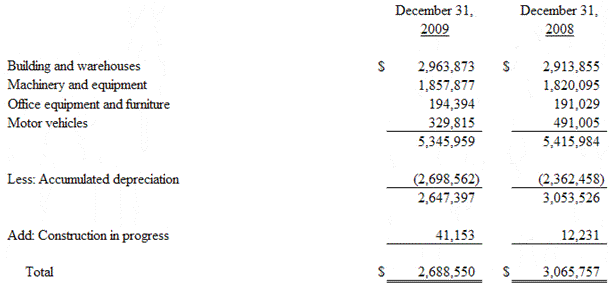
17
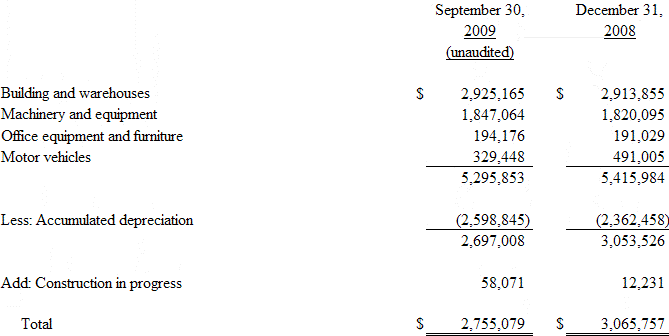
Asset Lease
On March 4, 2002, Baishui Dukang signed a lease agreement with Shaanxi Sanjiu Dukang Liquor Production Co., Ltd ("Sanjiu"), pursuant to which Dukang agreed to lease all fixed assets of Sanjiu for a period of 20 years, which was latter extended to 30 years. On February 3, 2005, Sanjiu was acquired by Shannxi Baishui Dukang Liquor Development Co., Ltd. On April 30, 2005, Baishui Dukang signed a supplemental lease agreement with Shannxi Baishui Dukang Liquor Development Co., Ltd, pursuant to which Dukang agreed to continue to lease all fix assets of Sanjiu for the rest of the original 30-year period. Bai Shui Dukang also agreed to pay $362,450 (RMB 3,000,000) to continue the lease and to absorb the pension and unemployment insurance expenses of Sanjiu's original employees. Baishui Dukang amortized the $362,450 (RMB 3,000,000) over a 27-year beneficial period. Dukang paid $129,476 and $161,841 for Sanjiu's original employees' pension and unemployment insurance expenses in the year ended December 31, 2009 and 2008, respectively.
ITEM 3. LEGAL PROCEEDINGS.
The Company’s prior CEO, Howard Wayland, Jr., filed for protection from creditors under Chapter 7 of the United States Bankruptcy Code in Houston, TX. Mr. Wayland resigned as CEO in 2008 and resigned as a director prior to filing the petition. Mr. Wayland discharged, among other things, various guarantees he had made in connection with the prior operations of the Company.
We are not presently involved in any litigation that is material to our business. We are not aware of any pending or threatened legal proceedings. In addition, none of our officers, directors, promoters or control persons has filed or been involved for the past five years:
l
in any bankruptcy petition
l
in any conviction of a criminal proceeding or involved in a pending criminal proceeding (excluding traffic violations and minor offenses)
l
is subject to any order, judgment or decree enjoining, barring suspending or otherwise limiting their involvement in any type of business, securities, or banking activities,
l
or has been found to have violated a federal or state securities or commodities law.
There have been no securities trading suspensions by any regulator, and there is no pending or threatened litigation for which the adverse effect, assuming an unfavorable outcome, would exceed $25,000.
ITEM 4. SUBMISSION OF MATTERS TO A VOTE OF SECURITIES HOLDERS
We did not submit any matters to a vote of security holders during the fiscal year of 2009.
20
ITEM 5. MARKET FOR REGISTRANT’S COMMON EQUITY, RELATED STOCKHOLDER MATTERS AND ISSUER PURCHASES OF EQUITY SECURITIES.
Trading Market for Common Equity
There is currently an extremely limited market for the Company's Common Stock, which is traded over-the-counter and quoted from time to time under the trading symbol "CDKG.PK". Prior to the reverse merger in January 2008, the company traded under the symbol “AFLH.” Consequently, there is currently no established public trading market for the Company's Common Stock.
Future sales of our common stock could put downward selling pressure on our shares, and adversely affect the stock price. There is a risk that this downward pressure may make it impossible for an investor to sell his shares at any reasonable price. Management believes that we currently have approximately 9,164 holders of common stock as of December 31, 2009.
The Company's Common Stock is traded over-the-counter and quoted from time to time in the Pink Sheets Electronic OTC Markets under the trading symbol "CDKG.PK".
The following table sets forth the range of high and low bid prices as reported by the Pink Sheets Electronic OTC Markets for the periods indicated. Such quotations represent inter-dealer prices without retail markup, markdown, or commission, and may not necessarily represent actual transactions. As of April 1, 2010 the opening bid was $.0012 and the closing bid was $.90 with 5000 shares traded.
CALENDAR YEARS
BY QUARTER
BID PRICE
--------------
----------
--------------
LOW HIGH
-----
-----
2008
First
$0.01
0.01
Second
0.015
0.25
Third
0.17
0.25
Fourth
0.01
0.20
2009
First
$0.01 $0.13
Second
0.015
0.025
Third
0.017
0.025
Fourth
0.01
0.02
Trading in the common stock in the over-the-counter market has been limited and sporadic and the quotations set forth below are not necessarily indicative of actual market conditions. Further, these prices reflect inter-dealer prices without retail mark-up, mark-down, or commission, and may not necessarily reflect actual transactions.
Dividends
21
We have never paid a cash dividend on our common stock. The payment of dividends may be made at the discretion of our Board of Directors, and will depend upon, among other things, our operations, capital requirements, and overall financial condition. There are no contractual restrictions on our ability to declare and pay dividends.
Number of Holders
As of March 31, 2010, we had 9,146 common shareholders of record.
Securities Authorized for Issuance Under Equity Compensation Plans
As of the date of this Report, we have not authorized any equity compensation plan, nor has our Board of Directors authorized the reservation or issuance of any securities under any equity compensation plan.
Recent Sales of Unregistered Securities
On or about January 28, 2008 the company issued 88,000,000 shares to Deng Guo Gang, the sole shareholder of HONGKONG MERIT ENTERPRISE LIMITED ("MERIT"). Mr. Deng Guo Gang was a “non-US person,” being a citizen and resident of the People’s Republic of China. Mr. Deng Guo Gang thereafter distributed the 88,000,000 shares to the shareholders of China Du Kang, all of which were “non-US persons,” being citizens and residents of the People’s Republic of China. We believe that the securities exchanged to the non-US persons were private placements under Section 4(2) under the Securities Act of 1933, as amended and exempt from registration under Regulation S as promulgated under the Act.
This transaction is being accounted for as a reverse merger, since the shareholders of Merit owns a majority of the outstanding shares of the Company’s common stock immediately following the share exchange. Merit is deemed to be the acquirer in the reverse merger. Consequently, the assets and liabilities and the historical operations that will reflected in the consolidated financial statements for periods prior to the share exchange will be those of Merit and its subsidiaries and will be recorded at the historical cost basis. After completion of the share exchange, the Company‘s consolidated financial statements will include the assets and liabilities of both Du Kang and Merit, the historical operations of Merit and the operations of the Company and its subsidiaries from the closing date of the share exchange.
AFLH also issued 362,200 shares of newly issued common voting shares to Sedgefield Capital Corporation for consulting services rendered by Sedgefield prior to the reverse acquisition by Hongkong Merit Enterprise Limited. The shares were issued in exchange for services valued at $25,000. The Company then changed its name to China Du Kang Co., Ltd..
In June, 2008, the Company issued 850,000 shares of common stock, valued at $17,000 to two Chinese consultants and their Chinese attorney. Also, in June 2008,150,000 shares of common stock, valued at $3,000, to its securities counsel, Charles Barkley.
We believe the securities offered in the exchange, including the common stock, were issued and sold in reliance upon exemptions from registration contained in Regulation S promulgated there under, which exempt transactions by an issuer not involving any public offering and issuances to non-US persons. The issuance of the shares was undertaken without general solicitation or advertising. Each recipient of the shares was a non- US person as defined in Regulation S, was acquiring the shares of for investment purposes and not with a view to any public resale or other distribution and otherwise met the requirements of Regulation S. In addition, the stock certificate representing these shares contained a legend that they are restricted securities under the Securities Act of 1933 pursuant to Regulation S.
Purchases of Equity Securities by the Small Business Issuer and Affiliated Purchasers
None.
Transfer Agent
Our transfer agent is Island Stock Transfer, Inc. located at100 Second Avenue South, Suite 705SSt. Petersburg, Florida 33701
ITEM 6. SELECTED FINANCIAL DATA
As the registrant qualifies as a smaller reporting company under Rule 229.10(f)(1), it is not required to provide this information.
ITEM 7. MANAGEMENT’S DISCUSSION AND ANALYSIS OR PLAN OF OPERATION
MANAGEMENT'S DISCUSSION AND ANALYSIS
For
CHINA DU KANG CO., LTD.,
CAUTIONARY NOTICE REGARDING FORWARD LOOKING STATEMENTS
The discussion contained in this prospectus contains "forward-looking statements" that involve risk and uncertainties. These statements may be identified by the use of terminology such as "believes", "expects", "may", or "should", or "anticipates", or expressing this terminology negatively or similar expressions or by discussions of strategy. The cautionary statements made in this prospectus should be read as being applicable to all related forward-looking statements wherever they appear in this prospectus. Our actual results could differ materially from those discussed in this prospectus. Important factors that could cause or contribute to such differences include those discussed under the caption entitled "risk factors," as well as those discussed elsewhere in this prospectus.
23
Cautionary statement identifying important factors that could cause actual results to differ from those projected in forward looking statements.
This document contains both statements of historical facts and forward looking statements. Forward looking statements are subject to certain risks and uncertainties, which could cause actual result to differ materially from those indicated by the forward looking statements. Examples of forward looking statements include, but are not limited to, (i) projection of revenues, income or loss, earnings per share, capital expenditures, dividends, capital structure, and other financial items, (ii) statements of our plans and objectives with respect to business transactions and enhancement of shareholder value, (iii) statements of future economic performance, and (iv) statements of assumptions underlying other statements and statements about our business prospects. This document also identifies important factors that could cause actual results to differ materially from those indicated by the forward looking statement. These risks and uncertainties include the factors discussed under the heading "Risk Factors" beginning at page 6 of this Prospectus.
The section "Management's Discussion and Analysis of Financial Condition and Results of Operations" should be read in conjunction with our audited consolidated or un-audited condensed consolidated financial statements and the notes thereto appearing elsewhere in this prospectus.
OVERVIEW
China Du Kang Co., Ltd (“China Du Kang” or the “Company”) was incorporated as U. S. Power Systems, Inc., in the State of Nevada on January 16, 1987. On or about June 8, 2006 the Company’s name was changed to Premier Organic Farms Group, Inc. On or about November 30, 2006 the name was changed to Amstar Financial Holdings, Inc. (“AFLH”). On or about March 18, 2008 the name was changed to its current name of China Du Kang Co., Ltd. with its corporate charter still residing in Nevada. The Company changed its fiscal year ending from September 30 to December 31 in February 2008.
The Company’ operations currently consist of sales of a line of proprietary liquors known generally in China as the Baishui Dukang series. These are clear liquors sold under a variety of trade names including Thirteen Cynasty, Jiu Zu Gong and Baishui. The Company’s products are sold mostly in larger urban areas in China throughthree long term marketing agreements.
On January 10, 2008, the Company entered into a Plan of Exchange Agreement (the “Exchange Agreement”) with Hong Kong Merit Enterprise Limited (“Merit”), a holding company incorporated in Hong Kong. Pursuant to the terms of the Exchange Agreement, the Company agreed to issue post split 88,000,000 shares of its common stock to the shareholders of Merit in exchange for Merit to transfer all of its issued and outstanding shares of common stock to the Company, thereby causing Merit to become a wholly-owned subsidiary of the Company. The parties closed the transaction contemplated by the Agreement on February 11, 2008.
This transaction is being accounted for as a reverse merger, since the shareholders of Merit owns a majority of the outstanding shares of the Company’s common stock immediately following the share exchange. Merit is deemed to be the acquirer in the reverse merger. Consequently, the assets and liabilities and the historical operations that will reflected in the consolidated financial statements for periods prior to the share exchange will be those of Merit and its subsidiaries and will be recorded at the historical cost basis. After completion of the share exchange, the Company‘s consolidated financial statements will include the assets and liabilities of both Du Kang and Merit, the
historical operations of Merit and the operations of the Company and its subsidiaries from the closing date of the share exchange.
Merit was incorporated on September 8, 2006 in Hong Kong under the Companies Ordinances as a Limited Liability company. Merit was formed for the purpose of seeking and consummating a merger or acquisition with a business entity organized as a private corporation, partnership, or sole proprietorship.
On January 22, 2008, Merit entered into a Share Purchase Agreement (the “Purchase Agreement”) with the owners of Shaanxi Huitong Food Co., Inc. ("Huitong"), a limited liability company incorporated in the People's Republic of China ("PRC") on August 9, 2007 with a registered capital of $128,200 (RMB1,000,000). Pursuant to the Purchase Agreement, Merit agreed to purchase 100% of the equity ownership in Huitong for a cash consideration of $136,722 (RMB 1,000,000). The local government approved the transaction on February 1, 2008. Subsequent to the completion of the acquisition, Huitong became a wholly-owned subsidiary of Merit.
Huitong was formed for the purpose of seeking and consummating a merger or acquisition with a business entity organized as a private corporation, partnership, or sole proprietorship. On December 26, 2007, Huitong executed an acquisition agreement with shareholders of Shaanxi Merithui Technology Stock Co., Ltd. ("Xidenghui"), whereby Huitong agreed to acquire 98.24% of the equity ownership of Xidenghui from the shareholders. Subsequent to completion of the acquisition agreement, Xidenghui became a majority-owned subsidiary of Huitong.
Xidenghui was incorporated in Weinan City, Shannxi Province, PRC on March 29, 2001 under the Company Law of PRC. Xidenghui was engaged in the business of production and distribution of distilled spirit with a brand name of “Xidenghui”. Currently, its principal business is to hold an equity ownership interest in Shannxi Baishui Dukang Liquor Co., Ltd. (“Baishui Dukang”) and Shaanxi Baishui Dukang Liquor Brand Management Co., Ltd. (“Brand Management”).
Baishui Dukang was incorporated in Baishui County, Shanxi Province, PRC on March 1, 2002 under the Company Law of PRC. Baishui Dukang was principally engaged in the business of production and distribution of distilled spirit with a brand name of “Baishui Du Kang”. On May 15, 2002, Xidenghui invested inventory and fixed assets, with a total fair value of $ 4,470,219 (RMB 37,000,000) to Baishui Dukang and owns 90.51% of Baishui Dukang’s equity interest ownership, thereby causing Baishui Dukang to become a majority-owned subsidiary of Xidenghui.
We authorize liquor manufacturers who comply with our requirements to use certain sub brand names of “Baishui Dukang” to process the production of liquor and to sell to customers within the designated area in a certain period of time. The amount of franchise fee varies based on the sales territory and the number of sub brand names. We generally collect the entire franchise fee when the franchise contract is executed, and then recognize franchise fee revenue over the beneficial period described by the contract, as the revenue is realized or realizable and earned. We also authorize liquor stores who comply with our requirements to exclusively sell certain sub brand names of “Baishui Dukang” products within the designated area in a certain period of time. The amount of franchise fee varies based on the sales territory and the number of sub brand names. We generally collect the entire franchise fee when the franchise c ontract is executed, and then recognize franchise fee revenue over the beneficial period
described by the contract, as the revenue is realized or realizable and earned
On October 30, 2007, Xidenghui executed an agreement with Mr. Zhang Hongjun, a PRC citizen, to establish a joint venture, Shaanxi Baishui Dukang Liquor Brand Management Co., Ltd. ("Brand Management"). Pursuant to the agreement, Xidenghui contributed cash of $95,704 (RMB 700,000), and owns 70% equity interest ownership therein. Brand Management was subsequently incorporated on November 12, 2007. Upon the completion of incorporation, Brand Management became a majority-owned subsidiary of the Xidenghui. Brand Management is principally engaged in the business of distribution of Baishui Dukang’s liquor and manage the franchise of the “Baishui Du Kang” brand name.
Baishui Dukang and Brand Management are the two of these affiliated companies that are engaged in business operations. Du Kang, Merit, Huitong, and Xidenghui are holding companies, whose business is to hold an equity ownership interest in Baishui Dukang and Brand Management. All these affiliated companies are hereafter referred to as the "Company". Currently, the Company is principally engaged in the business of production and distribution of distilled spirit with the brand name of “Baishui Dukang”. The Company also franchises the brand name to other liquor predictors. The Company's structure is summarized in the following chart.
26
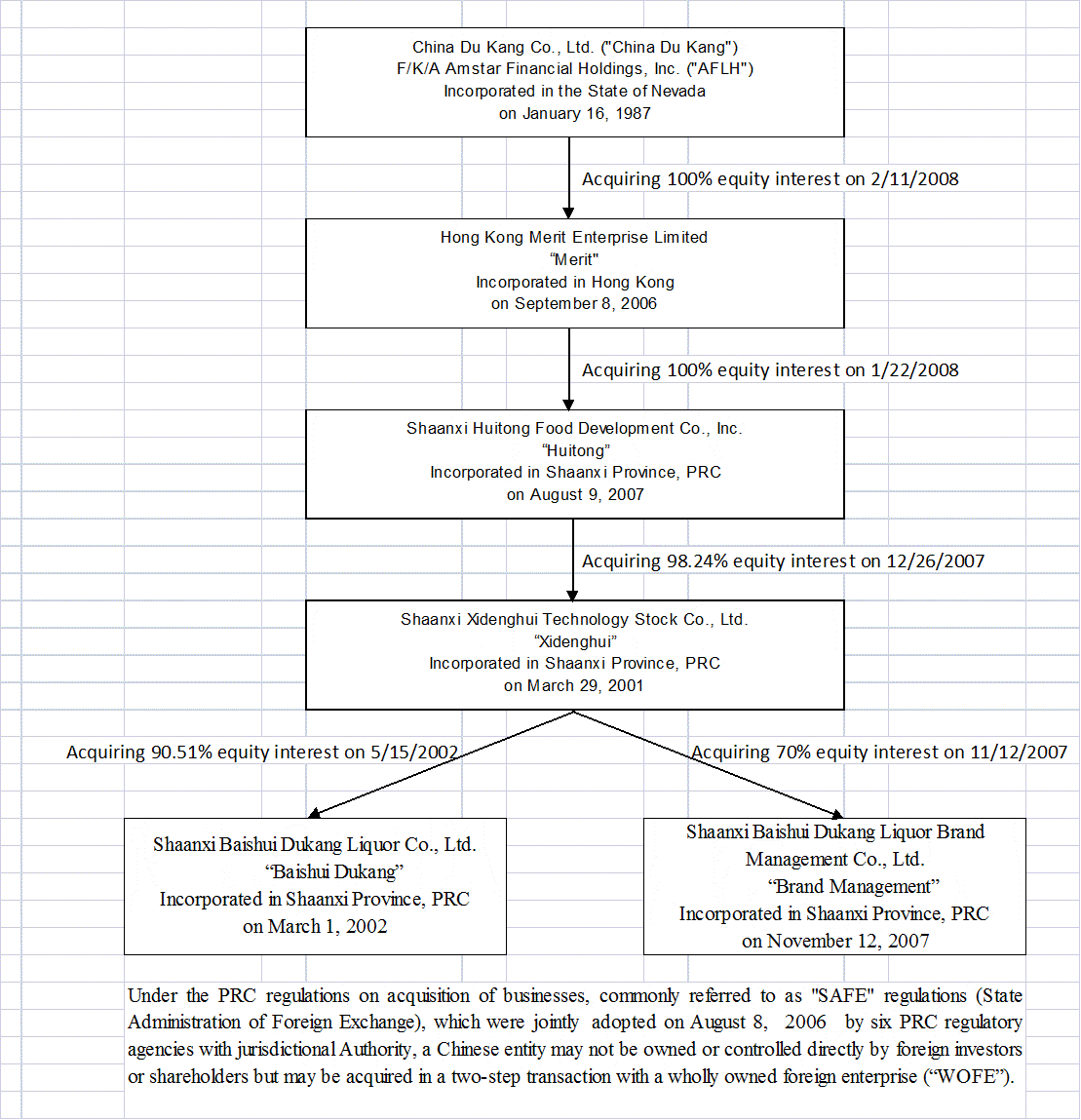
RESULTS OF OPERATIONS
COMPARISON OF THE YEARS ENDED DECEMBER 31 2008 AND DECEMBER 31, 2009
REVENUES
Gross revenues were $1,987,659 and $1,143,195 for the years ended December 31, 2009 and 2008 respectively due primarily to the sales of liquor and the sale of franchise fees. We recognize revenue when the earning process is complete. Revenues increased from $1,143,195 in the year ended December 31, 2008 to $1,987,659 for the year ended December 31, 2009. Most of the increase was attributable to an increase in franchise fees from $189,444 to $927,965 from the year ended 2008 to the year ended 2009, representing an increase of $738,521. Increase in franchise fees resulted from additions to our strategic partners. We expected our franchise fees will increase in 2010 as we will designate our brand name to more franchisees. Sales of liquor also increased slightly from $953,751 as of December 31, 2008 to $1,059,694 as of December 31, 2009, an increase of $105,943. We have designated exclusive distributors in different regions. The pricing and terms varies slightly from region to region. We expect sales to increase during 2010 as we implement our sales strategy to sell additional distributorships and to increase sales generated by distributors.
Inventory
Our inventory is aged to improve the taste and smoothness of the finished product. Total storage time is approximately three (3) years, so our inventory turnover rate typically exceeds 1,000 days. We believe our practices are standard in the liquor industry in China. The base wine of our liquors goes through a production process that includes weighing, measuring, sampling and tasting, and chromatographic analysis of the production microcomponents before the finished goods come off the production line. When the base wine comes off the production line, the product is extremely bitter and is generally not smooth enough for sale.
Some finished goods will be stored for 3 years in total, initially through a 2-year storage in wooden containers and then a 1-year jar storage. This storage process creates a chemical process for the stored wine that goes into flavor blending before packaging. After packaging, the products will also be stored for 3 months. We then conduct random inspection and testing before releasing the production run for the market.
Although we experience an extended time for inventory turnover, our rates are favorable within the industry. Some good quality base wine are stored for several decades for flavor blending. At present, national liqour industry performance is subject to PRC National Standard GB/T14867-2007 Feng-flavor Chinese Spirit, GB/T10781.1-2006 Strong Aromatic Chinese Spirits, and business standards Q/SBDJ01-2002 Mixed-Flavor (Feng,
Strong Aromatic and Jiang) Chinese Spirits and Q/SBDJ03-2002 Feng and Strong Aromatic Flavor Chinese Spirits. These requirements set forth the minimum storage requirements for truthful labeling and sale. In short, the more years base wine stored for, the higher its market price will be.
Further, the storage of a certain quantity of base wine also assists in smoothing the fluctuations in grain price which can keep the productions cost competitive and dealing with peak and off peak seasonality.
Inventories are stated at the lower of cost or market value. Actual cost is used to value raw materials and supplies. Finished goods and work-in-progress are valued on the weighted-average-cost method. Elements of costs in finished good and work-in-progress include raw materials, direct labor, and manufacturing overhead.
Baishui Dukang, one of our subsidiaries, is engaged in the distillery business. Pursuant to the production requirement, it generally stores some newly generated inventory, mainly the work-in-progress, “liquor base”, which is newly distilled from sorghum, beyond one year. We reclassify this portion of inventory as non-current assets, as more fully disclosed in Note 6 to our consolidated statements.
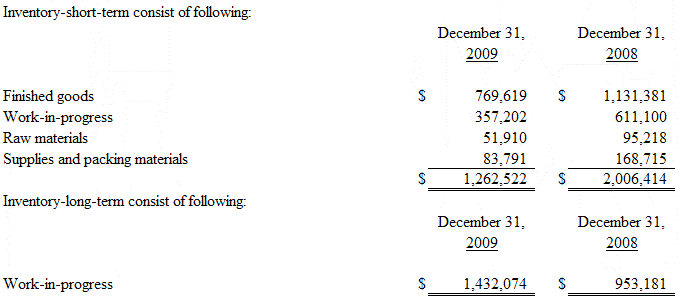
INCOME/LOSS
The company experienced a loss from operations of $(541,404) in the year ended December 31, 2009, which reflects an improvement of $1,036,807 from $1,578,211 in the year ended December 31, 2008, The improvement was attributable to an increase in gross profit and a decrease in operation expenses.
OPERATING EXPENSES
Total operating expenses decreased from $1,902,852 in the year ended December 31, 2008 to $1,480,997 for the year ended December 31, 2009, representing an improvement of $421,855, or approximately 22%. The decrease in operating expenses was largely due to the decrease in general and administrative expenses, which was offset by the increase in selling expenses.
GENERAL AND ADMINISTRATIVE EXPENSES
Our general and administrative expenses reduced from $1,531,455 in the year ended December 31, 2008 to $1,015,248 for the year ended December 31, 2009. The decrease was largely attributed to the decrease of $328,080 in the professional fees and consultant fees from $388,645 in the year ended December 31, 2008 to $60,565 for the same period in 2009. The large professional and consultant fees in 2008 were related to our efforts for going public. Our office expenses also decrease from $222,774 in the year ended December 31, 2008 to $83,332 for the same period in 2009. Our travel and entertainment expense decrease $75,016 from $215,369 in the year ended December 31, 2008 to $140,353 in the same period in 2009 due to less overseas travel for going public.
SELLING EXPENSES
Selling expenses increase $94,352 from $371,397 in the year ended December 31, 2008 to $465,749 for the year ended December 31, December 31, 2009. The increase is due to an increase in promotion expenses from $120,592 in the year ended December 31, 2008 to $256,417 for the same period in 2009, a difference of $135,825, due to the costs of the conference that we attended to promote our products. We also increased our travel and entertainment expenses from $41,547 to $56,327 for the same periods due to the inspection of our franchisees. Package design decreased by $56,213, from $73,252 in the year ended December 31, 2008 to $17,039 for the year ended December 31, 2009, as we finished most of the package design for our products in 2008.
LIQUIDITY AND CAPITAL RESOURCES
Net cash used by operating activities for years ended December 31, 2008 and 2009 were $(1,169,098) to $(475,309) respectively. The decrease in net cash used by operating activities were primarily due to the improvement in the net loss from $ (1,502,067) to $(532,075); and the decrease in inventory, as well as the increase in accounts payable, which was offset by the increase in prepaid expense and decrease of in deferred revenue.
30
Cash flows used in investment activities were $(776,073) to $(554,304) for the years ended December 31, 2009 and December 2008, respectively. The increase was due primarily to the loans that we made to our non-consolidated subsidiary, Shaanxi Yellow-river Wetlands Park Co., Ltd.
Net cash provided by financing activities for the years ended December 31, 2009 and 2008 were $1,033,872 and $1,409,517, respectively. The majority of decrease was attributed to our less borrowing from our affiliates in the current.period. Instead, we borrow $292,360 from a local bank, and we paid back of this loan in January 2010.
We have historically funded our cash needs through a series of debt a transactions, primarily with related parties. Our officers and directors and related parties have assured us that they will continue to provide capital infusions sufficient to fund operations over the next 12 months as needed, but they are under no legal obligation to do so. If our related parties are unable or unwilling to provide additional capital infusions we would likely require additional financing which would likely be on more unfavorable terms. If we are unable to attain additional capital there would likely be a material adverse affect on our operations and financial condition.
The related-parties include affiliates and individuals. Affiliates are companies which are directly or indirectly, beneficially and in the aggregate, majority-owned and controlled by directors, officers, and principal shareholders of the Company. Individuals include our officers, shareholders, and prior directors of subsidiaries .
Loans from related-parties are unsecured, non-interest bearing and have no fixed terms of repayment, therefore, deemed payable on demand. Accordingly, we have not paid any interest on these loans. Cash flows from due from related parties are classified as cash flows from investing activities. Cash flows from due to related parties are classified as cash flows from financing activities.
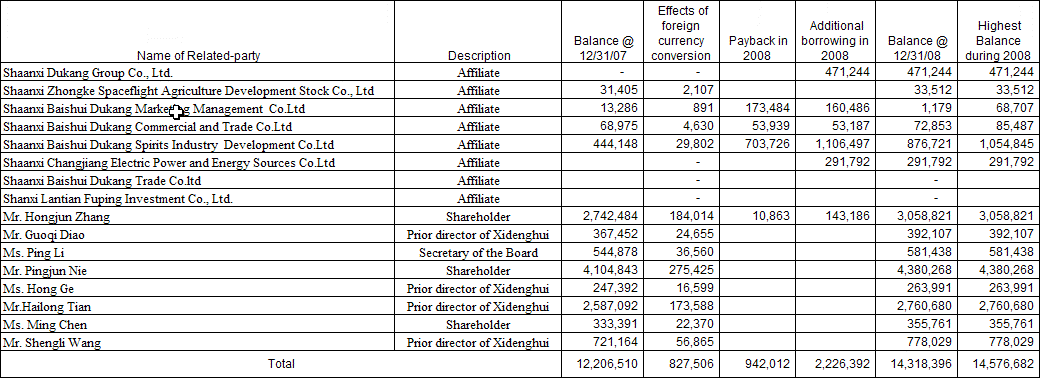
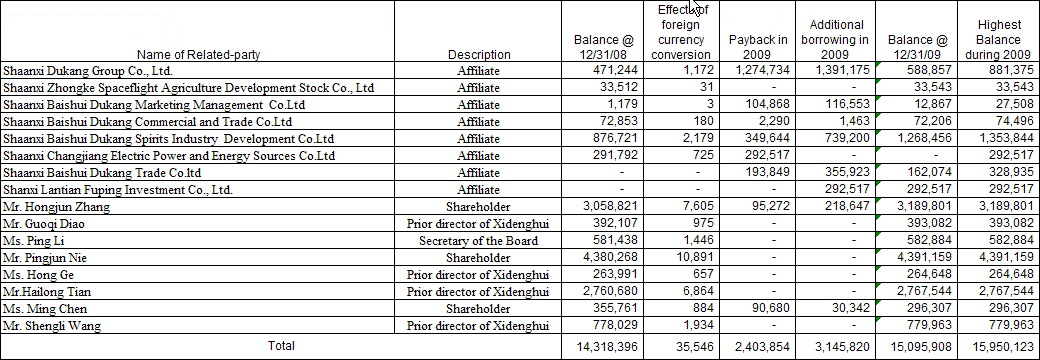
We have cash of $698,050 at the beginning of the 2009 period and cash of $619.472 at the end of the period. We have cash sufficient to fund operations for approximately 12 months assuming that sales and margins remain constant.
Our liquidity is dependent upon the continuation of and expansion of our operations, receipt of revenues and additional infusions of capital provided by equity and debt financing. Management believes that the current program of sales through distributorship agreements will improve throughout 2010 and that margins overall will continue to improve thereby. Demand for our products is dependent on market acceptance of our liquor and conditions in the liquor and general beverage markets, and general economic conditions. All of our products are currently sold in the Peoples Republic of China and are heavily dependent on the economy, exchange rates, and consumption habits within the Peoples Republic of China. Many of these factors are cyclical and beyond the control of management.
CAPITAL RESOURCES
General
Access to short and long term sources of cash is important to the continuation of our research and development and commencement of our operations. Our ability to operate is limited by our financial capacity to obtain cash and additional lines of credit in the future.
Total assets for the periods ending 2009 and 2008 were $9,867,391 and $9,293,486 respectively. Total current assets increased for the same periods from $3,074,869 to $3,567,686, which was primarily attributable to the increase of loans to related-party, and the increase in prepaid expense to purchase raw materials.
32
Property, plant and equipment declined from $3,065,757 at December 31, 2008 to $2,688,550 at December 31, 2009. For the same respective periods inventory long term increased from $953,181 to $1,432,074 as we store more “wine base” for the future production. Liabilities increased from December 31, 2008 to December 31, 2009 from $15,810,918 to $16,999,234 We had bank loans of $292,517 at December 31, 2009. Amounts due to related parties were the most significant change of current liabilities increasing from $14,318,396 at December 31, 2008 to $15,095,908 at December 31, 2009, as we obtained more loans from related-parties.
Shareholder Equity
Shareholders equity for the periods ending December 31, 2009 and December 31, 2008 were $(7,131,843) and $(6,517,432) respectively. The increase in shareholders’ deficit was due to the loss in the year ended December 31, 2009.
Impact of Inflation.
We believe that inflation will have a negligible effect on operations. The Company can offset inflationary increases in the cost of labor by increasing sales and improving operating efficiencies.
Liquidity and Capital Resources.
Access to short and long term sources of cash is important to the continuation of our research and development and commencement of our operations. Our ability to operate is limited by our financial capacity to obtain cash and additional lines of credit in the future.
33
We use cash primarily for:
- research and development
- general and administrative costs
-and other operating expenses.
So far, we have received cash primarily from shareholder loans and paid in capital.
The manufacturing facility is Shaanxi Bai Shui Du Kang Liquor Co., Ltd. The plant is located in South of Dukang Street, Town of Dukang, Baishui County, the city of Weinan, Shaanxi Province, 715600.
All of the equipment is used in our manufacturing process. The main equipmentsinclude:
Fermenter:grainfermentation
Crasher: before the fermentation of the grain, it is better to have it crashed and then it can fullly access to the distiller's yeast
Brewing equipment: which is also called Liquor distillation equipment. The well fermented semifinished products can be poured intoit. After heating, the Ethanol, water and various organic compounds can be fractioned by distillation.
Cellar: for the storage of the liquor after it is brewedLiquid filling machine: filling the liquor into the containers, such as the bottles
34
Capping machine: cover the bottle shutters
Labeling machine: affix labels on the products Packaging machine: put the bottles into the boxes.
Cartoning sealing machine : seal the boxes
Progressive assembly line: it can help to make the liquid filling, capping, labeling and packaging ect. Be completed in a assembly line. So it can speed up the production efficiency.
Off-Balance Sheet Arrangements.
None.
Critical Accounting Policies
Our financial statements and related public financial information are based on the application of accounting principles generally accepted in the United States (“GAAP”). GAAP requires the use of estimates; assumptions, judgments and subjective interpretations of accounting principles that have an impact on the assets, liabilities, revenue and expense amounts reported. These estimates can also affect supplemental information contained in our external disclosures including information regarding contingencies, risk and financial condition. We believe our use if estimates and underlying accounting assumptions adhere to GAAP and are consistently and conservatively applied. We base our estimates on historical experience and on various other assumptions that we believe to be reasonable under the circumstances. Actual results may differ materially from these estimates under different assumptions or conditi ons. We continue to monitor significant estimates made during the preparation of our financial statements.
Our significant accounting policies are summarized in Note 4 of our financial statements for the year ended December 31, 2009. While all these significant accounting policies impact our financial condition and results of operations, we view certain of these policies as critical. Policies determined to be critical are those policies that have the most significant impact on our financial statements and require management to use a greater degree of judgment and estimates. Actual results may differ from those estimates. Our management believes that given current facts and circumstances, it is unlikely that applying any other reasonable judgments or estimate methodologies would cause effect on our consolidated results of operations, financial position or liquidity for the periods presented in this report.
Item 7A.
We do not employ derivative financial instruments and have no foreign exchange contracts. Our financial instruments are primarily cash and cash equivalents, but also include receivables, payables, long term debts, and short term notes. We do not try to manage risk of foreign exchange rates or engage in hedging activities.
Foreign Exchange Rates
All of our sales are in the Chinese currency, Remnimbi (RMB) but our financial reporting is in U. S. dollars. We are therefore subject to the fluctuations in foreign exchange rates in our reporting requirements. While exchange rates between RMB and USD have been relatively stable, there can be no assurance that changes in foreign exchange rates will not have a material adverse impact on our financial reporting. The impact could express itself in reduced revenues and reduced or eliminatedearnings, which could have a negative effect on the prices for our securities.
The balance sheet amounts with the exception ofequity at December 31, 2009 were translated at 6.837 RMB to $1.00 USD as compared to 6.854 RMB at December 31, 2008. The equity accounts were stated at their historical rate.
Translation adjustments resulting from this process are included in accumulated other comprehensive income (loss) in the statement of changes in owners’ equity and amounted to $(452,408) and $(435,777) as of December 31, 2009 and 2008, respectively. The average translation rates applied to income statement accounts for the years ended December 31, 2009 and 2008 were 6.841 RMB and 6.962 RMB, respectively.
Translation adjustments resulting from this process are included in accumulated other comprehensive income (loss) in the statement of changes in owners’ equity and amounted to $(452,408) and $(435,777) as of December 31, 2009 and 2008, respectively. The balance sheet amounts with the exception of equity at December 31 , 2009 were translated at 6.837 RMB to $1.00 USD as compared to 6.854 RMB at December 31, 2008. The equity accounts were stated at their historical rate. The average translation rates applied to income statement accounts for 12 months ended December 31 2009 and 2008 were 6.841 RMB and 6.962 RMB, respectively.
ITEM 8. FINANCIAL STATEMENTS AND SUPPLEMENTARY DATA
36
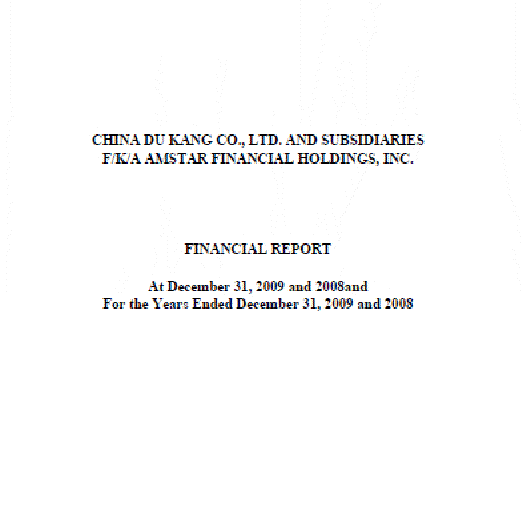
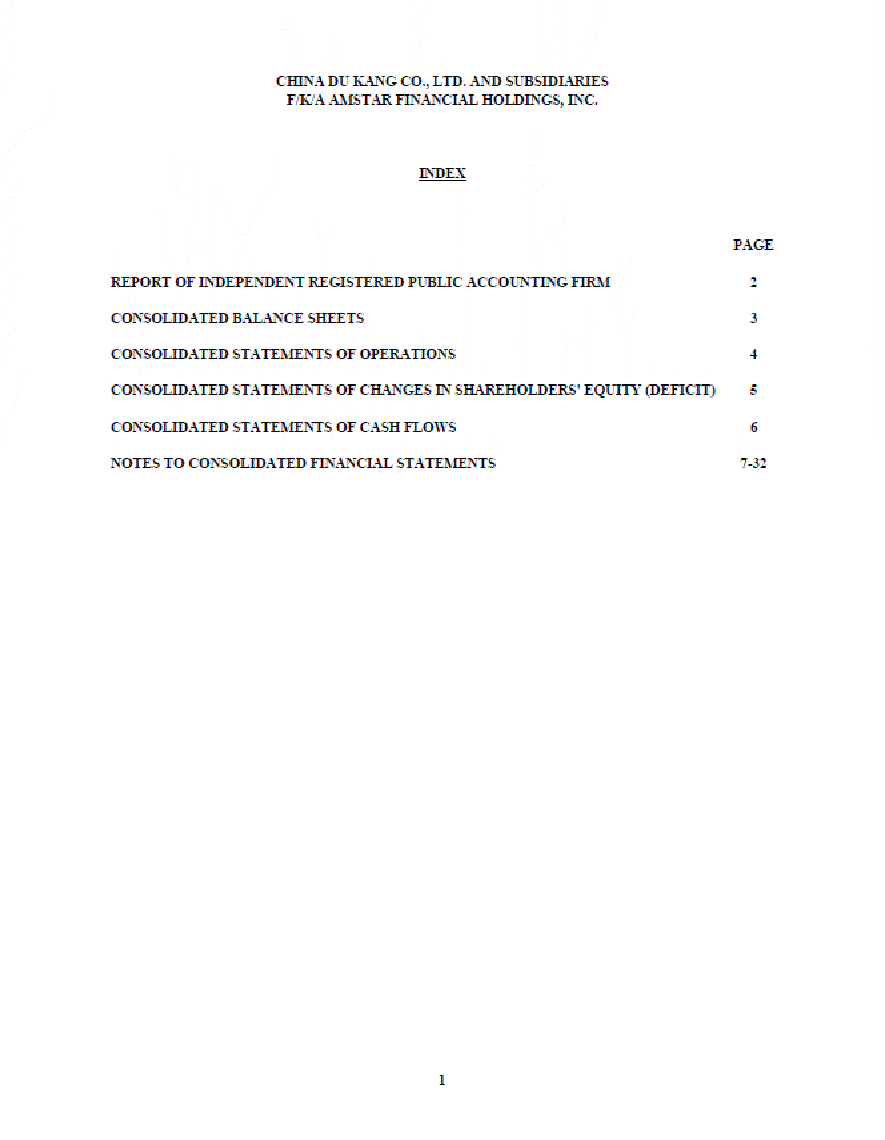
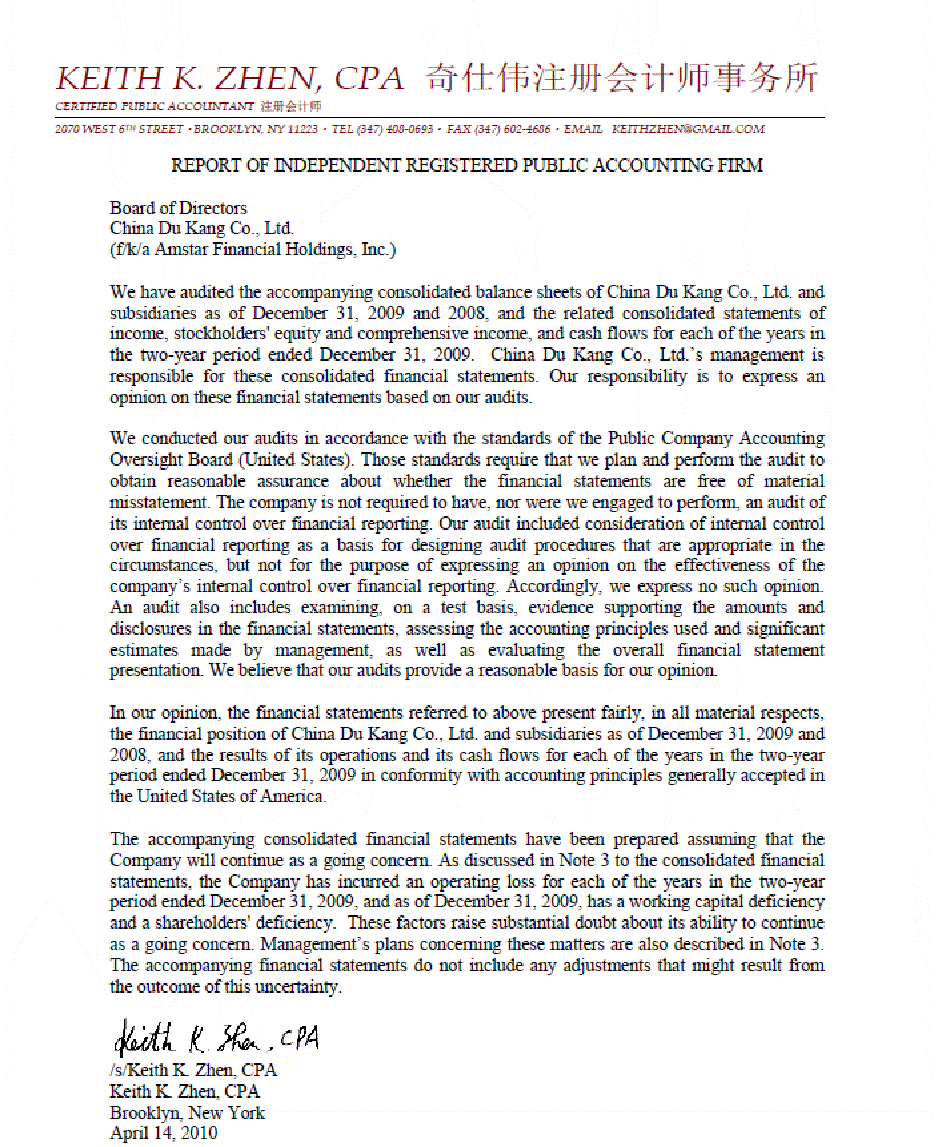
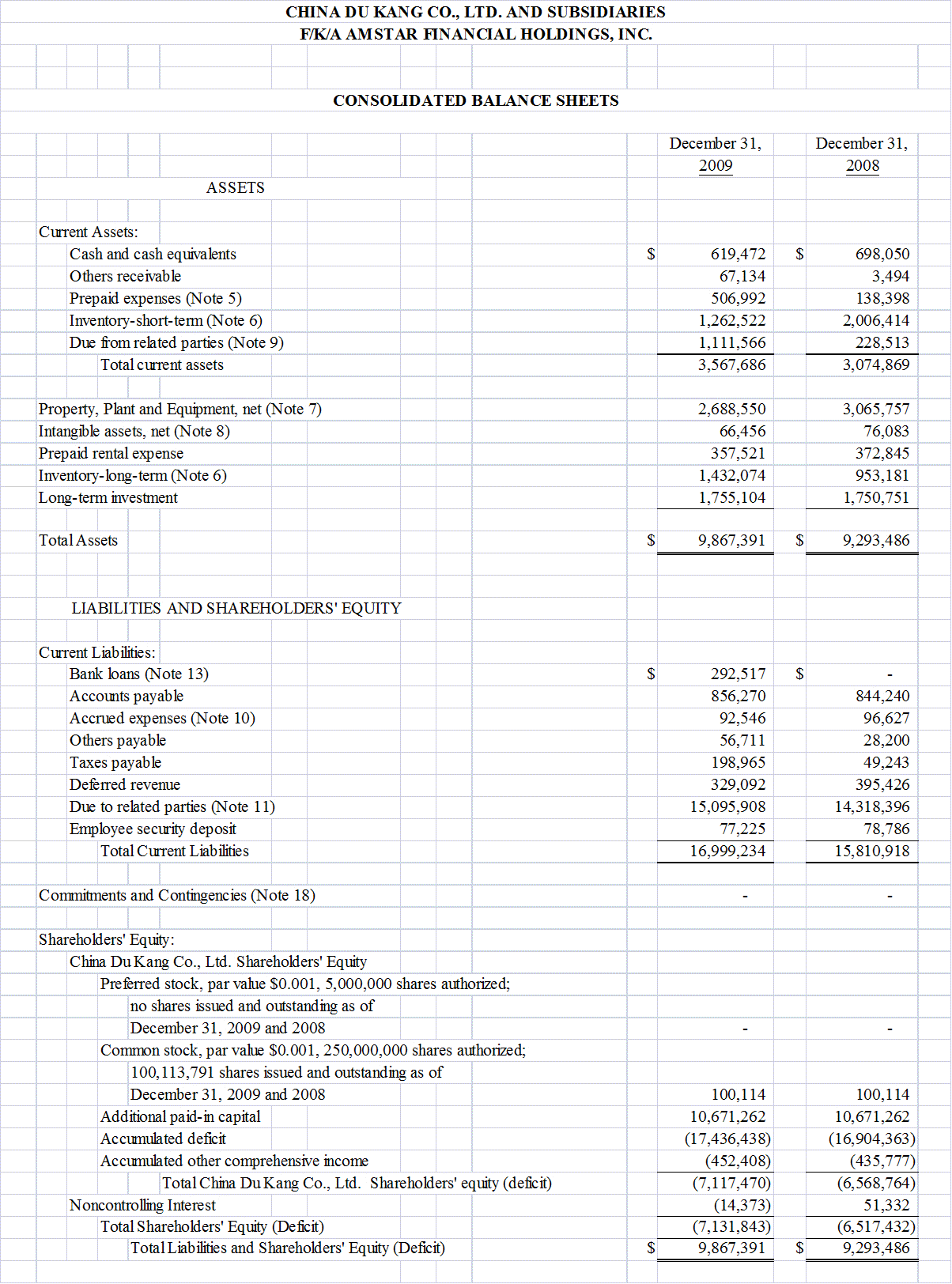
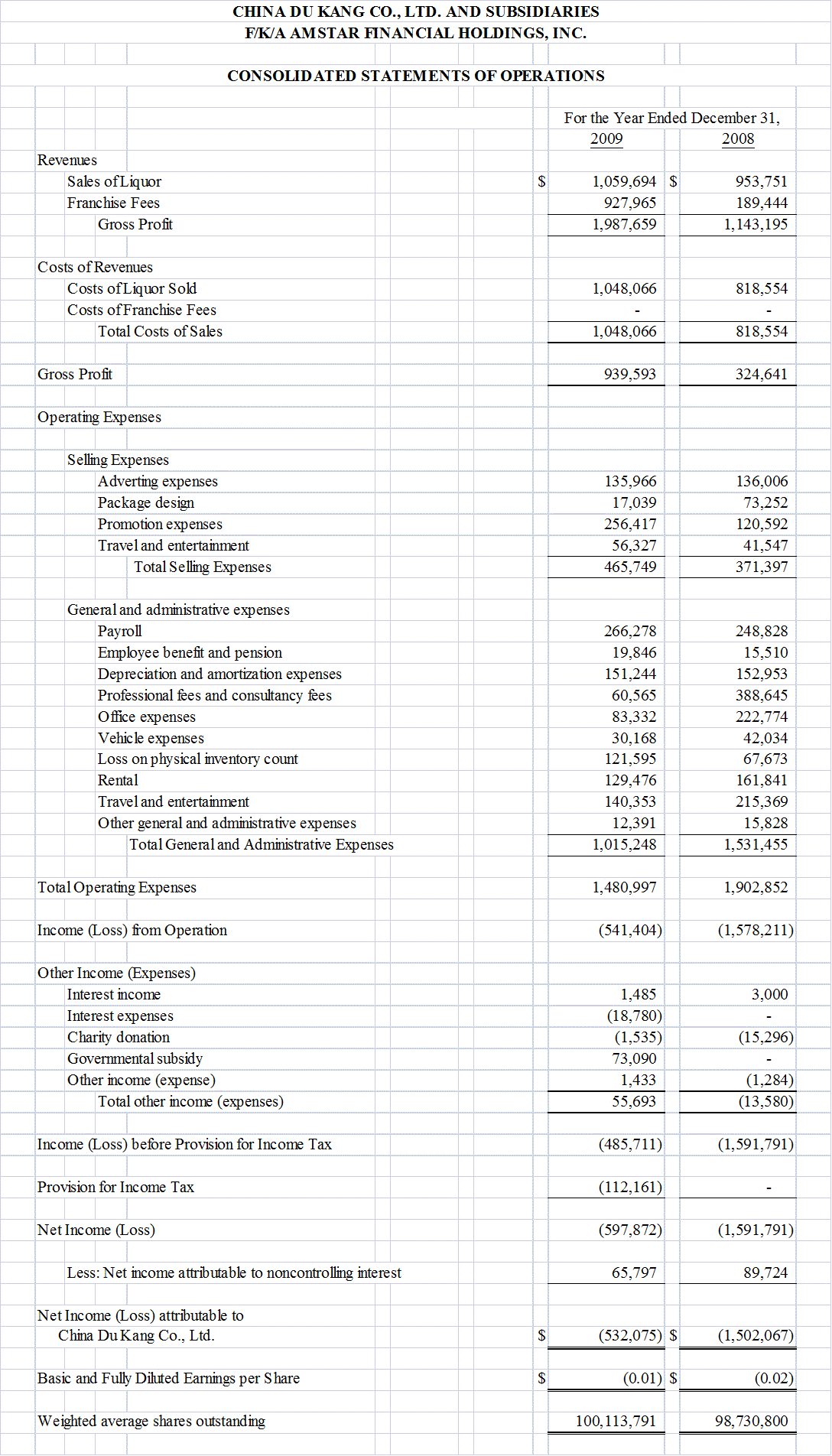
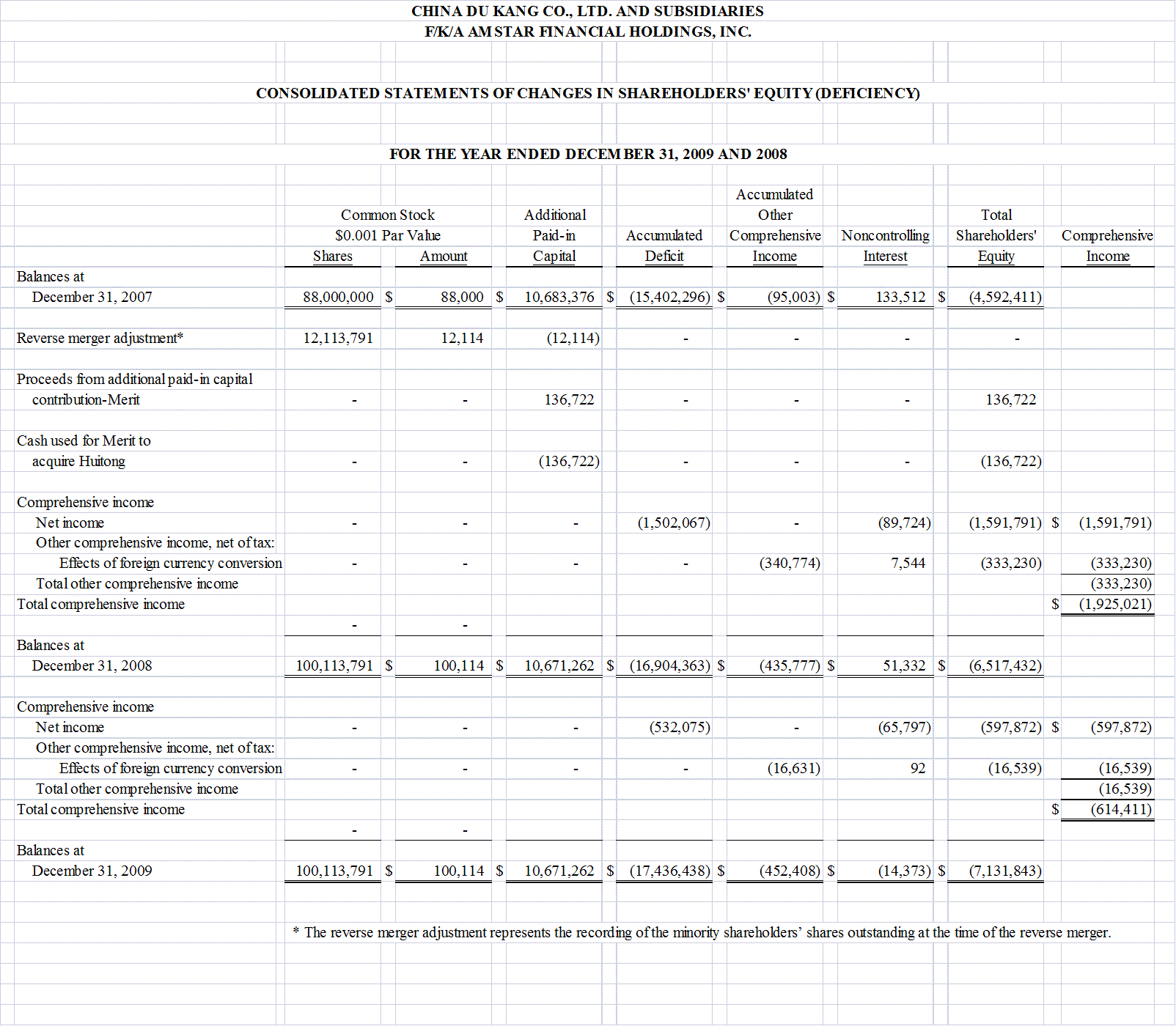
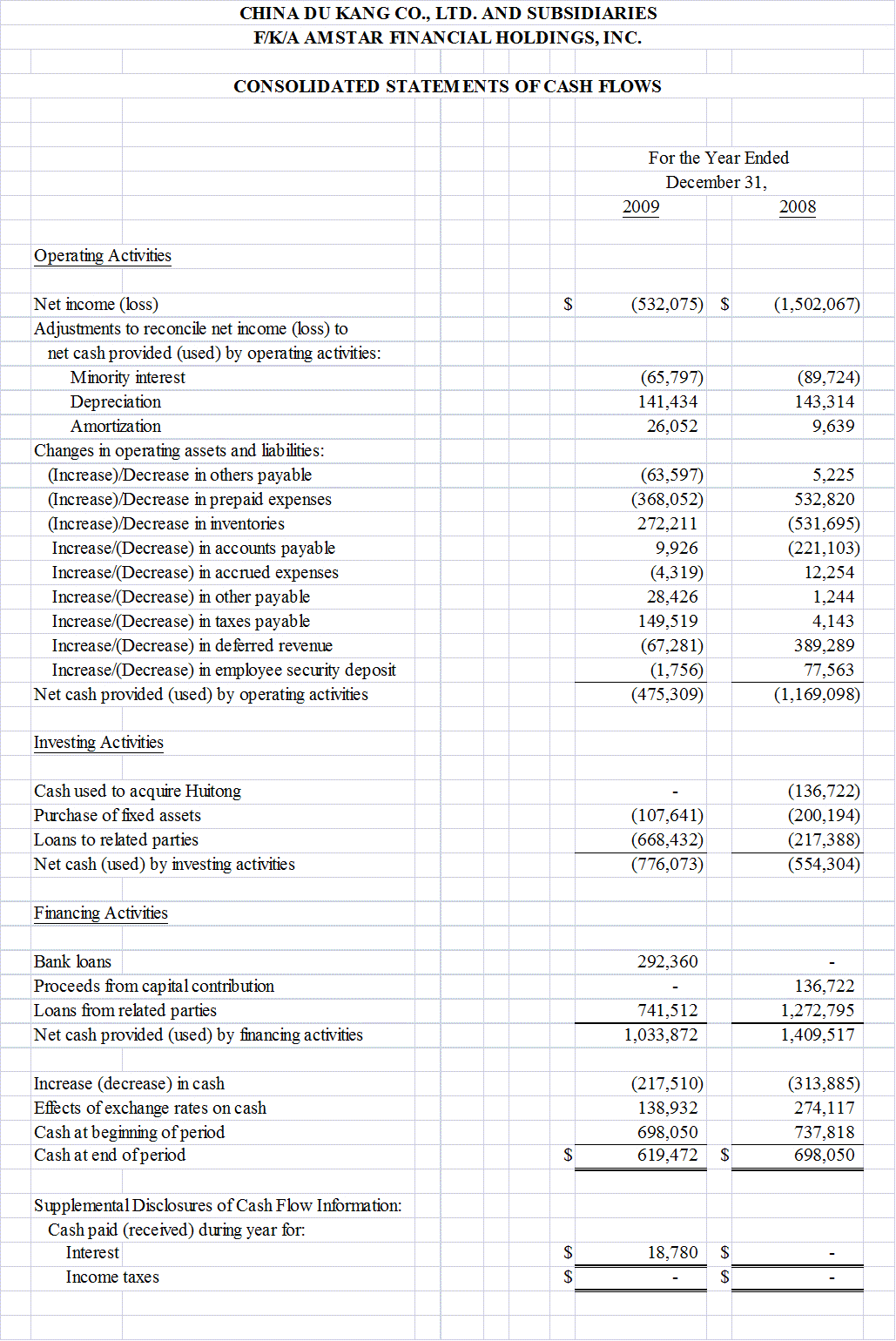
CHINA DU KANG CO., LTD. AND SUBSIDIARIES
NOTES TO CONSOLIDATED FINANCIAL STATEMENTS
F/K/A AMSTAR FINANCIAL HOLDINGS, INC.
Note 1- ORGANIZATION AND BUSINESS BACKGROUND
On January 10, 2008, the Company entered into a Plan of Exchange Agreement (the “Exchange
Agreement”) with Hong Kong Merit Enterprise Limited (“Merit”), a holding company incorporated
in Hong Kong. Pursuant to the terms of the Exchange Agreement, the Company agreed to issue post
split 88,000,000 shares of its common stock to the shareholders of Merit in exchange for Merit to
transfer all of its issued and outstanding shares of common stock to the Company, thereby causing
China Du Kang Co., Ltd (“China Du Kang” or the “Company”) was incorporated as U. S. Power
Systems, Inc., in the State of Nevada on January 16, 1987. On or about June 8, 2006 the Company’s
name was changed to Premier Organic Farms Group, Inc. On or about November 30, 2006 the name
was changed to Amstar Financial Holdings, Inc. (“AFLH”). On or about March 18, 2008 the name
was changed to its current name of China Du Kang Co., Ltd. with its corporate charter still residing
in Nevada. The Company changed its fiscal year ending from September 30 to December 31 in
February 2008.
The Company had been engaged in the business to provide various financial services since it's
incorporated. The Company was not successful and discontinued the majority of its operation by
December 31, 2007.
Merit to become a wholly-owned subsidiary of the Company. The parties closed the transaction
contemplated by the Agreement on February 11, 2008.
This transaction is being accounted for as a reverse merger, since the shareholders of Merit owns a
majority of the outstanding shares of the Company’s common stock immediately following the share
exchange. Merit is deemed to be the acquirer in the reverse merger. Consequently, the assets and
liabilities and the historical operations that will reflected in the consolidated financial statements for
periods prior to the share exchange will be those of Merit and its subsidiaries and will be recorded at
the historical cost basis. After completion of the share exchange, the Company‘s consolidated
financial statements will include the assets and liabilities of both Du Kang and Merit, the historical
operations of Merit and the operations of the Company and its subsidiaries from the closing date of
the share exchange.
Merit was incorporated on September 8, 2006 in Hong Kong under the Companies Ordinances as a
Limited Liability company. Merit was formed for the purpose of seeking and consummating a
merger or acquisition with a business entity organized as a private corporation, partnership, or sole
proprietorship.
7
On January 22, 2008, Merit entered into a Share Purchase Agreement (the “Purchase Agreement”)
with the owners of Shaanxi Huitong Food Co., Inc. ("Huitong"), a limited liability company
incorporated in the People's Republic of China ("PRC") on August 9, 2007 with a registered capital
of $128,200 (RMB1,000,000). Pursuant to the Purchase Agreement, Merit agreed to purchase
100% of the equity ownership in Huitong for a cash consideration of $136,722 (RMB 1,000,000).
The local government approved the transaction on February 1, 2008. Subsequent to the completion
of the acquisition, Huitong became a wholly-owned subsidiary of Merit.
Huitong was formed for the purpose of seeking and consummating a merger or acquisition with a
business entity organized as a private corporation, partnership, or sole proprietorship. On December
26, 2007, Huitong executed an acquisition agreement with shareholders of Shaanxi Xidenghui
Technology Stock Co., Ltd. ("Xidenghui"), whereby Huitong agreed to acquire 98.24% of the equity
ownership of Xidenghui from the shareholders. Subsequent to completion of the acquisition
agreement, Xidenghui became a majority-owned subsidiary of Huitong.
Xidenghui was incorporated in Weinan City, Shaanxi Province, PRC on March 29, 2001 under the
Company Law of PRC. Xidenghui was engaged in the business of production and distribution of
distilled spirit with a brand name of “Xidenghui”. Currently, its principal business is to hold an
equity ownership interest in Shannxi Baishui Dukang Liquor Co., Ltd. (“Baishui Dukang”) and
Shaanxi Baishui Dukang Liquor Brand Management Co., Ltd. (“Brand Management”).
Baishui Dukang was incorporated in Baishui County, Shanxi Province, PRC on March 1, 2002 under
the Company Law of PRC. Baishui Dukang was principally engaged in the business of production
and distribution of distilled spirit (liquor) with a brand name of “Baishui Du Kang”. On May 15,
2002, Xidenghui invested inventory and fixed assets with a total fair value of $ 4,470,219 (RMB
37,000,000) to Baishui Dukang and owns 90.51% of Baishui Dukang’s equity interest ownership,
thereby causing Baishui Dukang to become a majority-owned subsidiary of Xidenghui.
On October 30, 2007, Xidenghui executed an agreement with Mr. Zhang Hongjun, a PRC citizen, to
establish a joint venture, Shaanxi Baishui Dukang Liquor Brand Management Co., Ltd. ("Brand
Management"). Pursuant to the agreement, Xidenghui contributed cash of $95,704 (RMB 700,000),
and owns 70% equity interest ownership therein. Brand Management was subsequently
incorporated on November 12, 2007. Upon the completion of incorporation, Brand Management
became a majority-owned subsidiary of the Xidenghui. Brand Management is principally engaged
in the business of distribution of Baishui Dukang’s liquor and manage the franchise of the “Baishui
Du Kang” brand name.
8
Baishui Dukang and Brand Management are the two of these affiliated companies that are engaged in
business operations. Du Kang, Merit, Huitong, and Xidenghui are holding companies, whose business is
to hold an equity ownership interest in Baishui Dukang and Brand Management. All these affiliated
companies are hereafter referred to as the "Company". Currently, the Company is principally engaged in
the business of production and distribution of distilled spirit with the brand name of “Baishui Dukang”.
The Company also franchises the brand name to other liquor productors. The Company's structure is
summarized in the following chart.
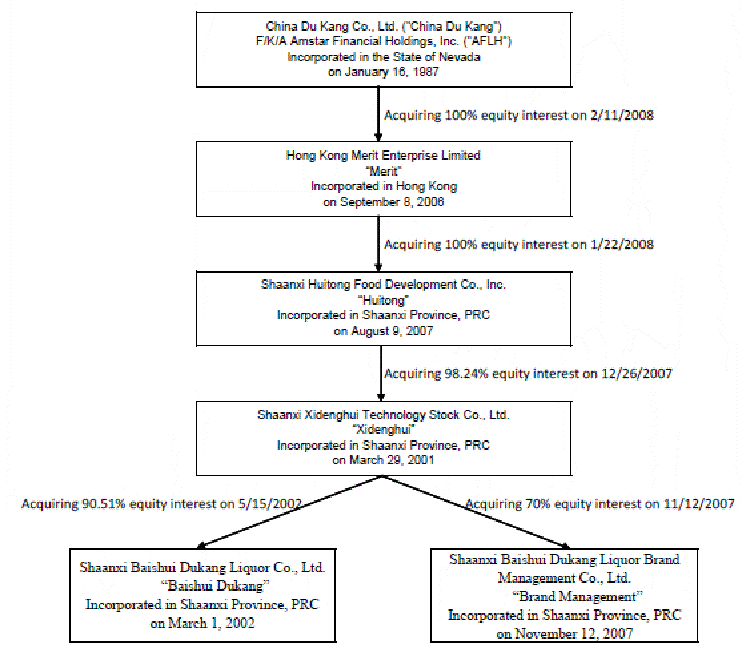
Under the PRC regulations on acquisition of businesses, commonly referred to as "SAFE" regulations
(State Administration of Foreign Exchange), which were jointly adopted on August 8, 2006 by six
PRC regulatory agencies with jurisdictional Authority a Chinese entity may not be owned or controlledAuthority, directly by foreign investors or shareholders but may be acquired in a two-step transaction with a wholly
owned foreign enterprise (“WOFE”).
9
China Du Kang is the US holding company for Merit, a Hong Kong entity organized under the
Companies Ordinance as a limited liability company. Merit was established as a WOFE corporation
for the purpose of effecting an acquisition transaction with Huitong, a WOFE corporation
incorporated in PRC. Huitong in turn contracted with Xidenghui, which was a Chinese holding
company. Xidenghui had two subsidiaries, Baishui Dukang and Brand Management.
This arrangement provides separate holding companies for the United States, Hong Kong, and PRC.
This allows the Company to lawfully conduct operations in China while ownership is represented in
shares of the U. S. holding company.
Note 2- CONTROL BY PRINCIPAL OWNERS
The directors, executive officers, their affiliates, and related parties own, directly or indirectly,
beneficially and in the aggregate, the majority of the voting power of the outstanding capital of the
Company. Accordingly, directors, executive officers and their affiliates, if they voted their shares
uniformly, would have the ability to control the approval of most corporate actions, includingapproving significant expenses, increasing the authorized capital and the dissolution, merger or sale
of the Company's assets.
Note 3- GOING CONCERN
As reflected in the accompanying consolidated financial statements, the Company had an
accumulated deficit of $17,436,438 at December 31, 2009 that includes losses of $597,872 and
$1,591,791 for the year ended December 31, 2009 and 2008, respectively. In addition, The
Company had a working capital deficiency of $13,431,548 and a shareholders' deficiency of
$7,131,843 at December 31, 2009. These factors raise substantial doubt about its ability to continue
as a going concern.
Management has taken steps to revise the Company's operating and financial requirements. The
Company is actively pursuing additional funding and a potential merger or acquisition candidate and
strategic partners, which would enhance owners' investment. However, there can be no assurance
that sufficient funds required during the next year or thereafter will be generated from operations or
that funds will be available from external sources such as debt or equity financings or other potential
sources. The lack of additional capital resulting from the inability to generate cash flow from
operations or to raise capital from external sources would force the Company to substantially curtail
or cease operations and would, therefore, have a material adverse effect on its business.
Furthermore, there can be no assurance that any such required funds, if available, will be available
on attractive terms or that they will not have a significant dilutive effect on the Company's existing
stockholders.
The accompanying financial statements do not include any adjustments related to the recoverability
or classification of asset-carrying amounts or the amounts and classification of liabilities that may
result should the Company be unable to continue as a going concern.
The Company relied heavily for its financing needs on its affiliates shareholders/directors as more
affiliates, fully disclosed in Note 11.
10
Note 4- SIGNIFICANT ACCOUNTING POLICIES
Basis of Presentation
The accompanying consolidated financial statements are prepared in accordance with generally
accepted accounting principles in the United States of America ("US GAAP"). This basis of
accounting differs from that used in the statutory accounts of the Company, which are prepared in
accordance with the "Accounting Principles of China " ("PRC GAAP"). Certain accounting
principles, which are stipulated by US GAAP, are not applicable in the PRC GAAP. The difference
between PRC GAAP accounts of the Company and its US GAAP consolidated financial statements
is immaterial.
The consolidated financial statements include the accounts of the Company and all its majorityowned
subsidiaries which require consolidation. Inter-company transactions have been eliminated
in consolidation.
Certain amounts in the prior year's consolidated financial statements and notes have been revised to
conform to the current year presentation.
Use of Estimates
The preparation of financial statements in conformity with generally accepted accounting principles
requires management to make estimates and assumptions that affect the reported amounts of assets
and liabilities and disclosure of contingent assets and liabilities at the date of the financial
statements, and the reported amounts of revenue and expenses during the reporting period. Actual
results when ultimately realized could differ from those estimates.
Subsequent Events
The Company evaluated subsequent events through the time of filing this Annual Report on Form 10
onApril 14, 2010. We are not aware of any significant events that occurred subsequent to the
balance sheet date but prior to the filing of this report that would have a material impact on our
consolidated financial statements.
11
Foreign Currencies Translation
The Company maintains its books and accounting records in PRC currency "Renminbi" ("RMB"),
which is determined as the functional currency. Transactions denominated in currencies other than
RMB are translated into RMB at the exchange rates quoted by the People’s Bank of China
(“PBOC”) prevailing at the date of the transactions. Monetary assets and liabilities denominated in
currencies other than RMB are translated into RMB using the applicable exchange rates quoted by
the PBOC at the balance sheet dates. Exchange differences are included in the statements of changes
in owners' equity. Gain and losses resulting from foreign currency transactions are included in
operations.
The Company’s financial statements are translated into the reporting currency, the United States
Dollar (“US$”). Assets and liabilities of the Company are translated at the prevailing exchange rate
at each reporting period end. Contributed capital accounts are translated using the historical rate of
exchange when capital is injected. Income and expense accounts are translated at the average rate of
exchange during the reporting period. Translation adjustments resulting from translation of these
consolidated financial statements are reflected as accumulated other comprehensive income (loss) inthe consolidated statement of shareholder’s equity.
Translation adjustments resulting from this process are included in accumulated other
comprehensive income (loss) in the statement of changes in owners’ equity and amounted to
$(452,408) and $(435,777) as of December 31, 2009 and 2008, respectively. The balance sheet
amounts with the exception of equity at December 31, 2009 were translated at 6.837 RMB to $1.00
USD as compared to 6.854 RMB at December 31, 2008. The equity accounts were stated at their
historical rate. The average translation rates applied to income statement accounts for the years
ended December 31, 2009 and 2008 were 6.841 RMB and 6.962 RMB, respectively.
Statement of Cash Flows
In accordance with FASB guidance, cash flows from the Company’s operations is calculated based
upon the functional currency. As a result, amounts related to assets and liabilities reported on the
statement of cash flows may not necessarily agree with changes in the corresponding balances on the
balance sheet.
12
Revenue Recognition
The Company recognizes revenue when the earnings process is complete, both title and the risks and
rewards of ownership are transferred or services have been rendered and accepted, the selling price
is fixed or determinable, and collectability is reasonably assured.
(1) Sales of Liquor
The Company generally sells liquor to liquor distributors with which the Company executed an
exclusive distributor contract, pursuant to which the distributor cannot act as a distributor for any
other products of the third party. The Company recognizes liquor sales revenue when the significant
risks and rewards of ownership have been transferred pursuant to PRC law, including such factors as
when persuasive evidence of an arrangement exists, delivery has occurred, the sales price is fixed or
determinable, sales and value-added tax laws have been complied with, and collectability is
reasonably assured. The Company generally recognizes revenue from sales of liquor when its
products are shipped.
The Company does not provide an unconditional right of return, price protection or any other
concessions to our customers. Sales returns and other allowances have been immaterial in our
operation.
(2) Franchise Fees
(a)Franchise Fees from liquor manufactures
We authorize liquor manufacturers who comply with our requirements to use certain sub brand
names of “Baishui Dukang” to process the production of liquor and to sell to customers within the
designated area in a certain period of time. The amount of franchise fee varies based on the sales
territory and the number of sub brand names. We generally collect the entire franchise fee when the
franchise contract is executed, and then recognize franchise fee revenue over the beneficial period
described by the contract, as the revenue is realized or realizable and earned.
(b)Franchise Fees from liquor stores
We also authorize liquor stores who comply with our requirements to exclusively sell certain sub
brand names of “Baishui Dukang” products within the designated area in a certain period of time.
The amount of franchise fee varies based on the sales territory and the number of sub brand names.
We generally collect the entire franchise fee when the franchise contract is executed, and then
recognize franchise fee revenue over the beneficial period described by the contract, as the revenue
is realized or realizable and earned.
13
Deferred Revenue
Deferred revenue consists of prepayments to the Company for products that have not yet been
delivered to the customers or services have not yet been rendered and accepted. Payments received
prior to satisfying the Company’s revenue recognition criteria are recorded as deferred revenue.
Cost of Franchise Fees
Costs of franchise fees principally include the costs to prepare the franchise contracts and the payroll
to employees who are responsible for inspection and monitoring the franchisees. These expenses are
immaterial and therefore included in the general and administrative expenses.
Cash and Cash Equivalents
Cash and cash equivalents include cash on hand, deposits in banks with maturities of three months
or less, and all highly liquid investments which are unrestricted as to withdrawal or use, and which
have original maturities of three months or less.
Other Receivable
Others receivable principally includes advance to employees who are working on projects on behalf
of the Company. After the work is finished, they will submit expense reports with supporting
documents to the accounting department. Upon being properly approved, the expenses are debited
into the relevant accounts and the advances are credited out. Cash flows from these activities are
classified as cash flows from operating activities.
Concentrations of Credit Risk
Financial instruments that subject the Company to concentrations of credit risk consist primarily of
cash and cash equivalents. The Company maintains its cash and cash equivalents with high-quality
institutions. Deposits held with banks in PRC may not be insured or exceed the amount of insurance
provided on such deposits. Generally these deposits may be redeemed upon demand and therefore
bear minimal risk.
Fair Value of Financial Instruments
The carrying value of financial instruments including cash and cash equivalents, receivables, prepaid
expenses, accounts payable, and accrued expenses, approximates their fair value due to the relatively
short-term nature of these instruments.
14
Inventory
Inventories are stated at the lower of cost or market value. Actual cost is used to value raw materials
and supplies. Finished goods and work-in-progress are valued on the weighted-average-cost method.
Elements of costs in finished good and work-in-progress include raw materials, direct labor, and
manufacturing overhead.
Baishui Dukang, one of our subsidiaries, is engaged in the distillery business. Pursuant to the
production requirement, it generally stores some newly generated inventory, mainly the work-in-progress,
“liquor base”, which is newly distilled from sorghum, beyond one year. We reclassify this
portion of inventory as non-current assets, as more fully disclosed in Note 6.
Property, Plant, and Equipment
Property, plant and equipment are carried at cost. The cost of repairs and maintenance is expensed as
incurred; major replacements and improvements are capitalized.
When assets are retired or disposed of, the cost and accumulated depreciation are removed from the
accounts, and any resulting gains or losses are included in income in the year of disposition.
Depreciation is calculated on a straight-line basis over the estimated useful life of the assets without
residual value. The percentages or depreciable life applied are:

Intangible Assets
Intangible assets are carried at cost. Amortization is calculated on a straight-line basis over the
estimated useful life of the assets without residual value. The percentages or amortizable life
applied are:

15
Land Use Right
All land belongs to the State in PRC. Enterprises and individuals can pay the State a fee to obtain a
right to use a piece of land for commercial purpose or residential purpose for an initial period of 50
years or 70 years, respectively. The land use right can be sold, purchased, and exchanged in the
market. The successor owner of the land use right will reduce the amount of time which has been
consumed by the predecessor owner.
The Company owns the right to use a piece of land, approximately 657 acre, located in Weinan City,
Shaanxi Province for a fifty-year period ended February 9, 2051. The costs of these land use rights
are amortized over their prospective beneficial period, using the straight-line method with no residual value.
Valuation of Long-Lived Assets
Long-lived assets and certain identifiable intangibles are reviewed for impairment whenever events
or changes in circumstances indicate that the carrying amount of an asset may not be recoverable.
Recoverability of assets to be held and used is measured by a comparison of the carrying amount of
an asset to future net cash flows expected to be generated by the asset. If such assets are considered
to be impaired, the impairment to be recognized is measured by the amount by which the carrying
amount of the assets exceeds the fair value of the assets. Assets to be disposed of are reported at the
lower of the carrying amount or fair value less costs to sell.
Long-Term Investment
On March 1, 2006, Xidenghui executed an investment agreement with Shaanxi Yichuan Nature Park
Co., Inc., pursuant to which, Xidenghui agreed to invest cash of $1,596,254 (RMB 12,000,000) to
establish a joint-venture named Huanghe Shidi Park Co., Inc., and owns 7.9% equity ownership
interest therein. Huanghe Shidi Park Co., Inc. is engaged in the business of recreation and
entertainment.
Xidenghui finished the investment contribution in September 2007. As the project is currently
ongoing, the Management believes the amount invested approximates the fair value and uses the
cost method to record the investment.
Advertising Costs
Advertising costs are expensed as incurred. The advertising costs were $135,966, and $136,006 for
the years ended December 31, 2009 and 2008, respectively.
16
Research and Development Costs
Research and development costs will be charged to expense as incurred. Research and development
costs were immaterial for the year ended December 31, 2009 and 2008, respectively.
Value-Added Tax (“VAT”)
Sales revenue represents the invoiced value of goods, net of a value-added tax (VAT). All of the
Company’s products that are sold in PRC are subject to a Chinese value-added tax at a rate of 17%
of the gross sales price or at a rate approved by the Chinese local government. This VAT may be
offset by VAT paid on purchase of raw materials included in the cost of producing the finished
goods. The Company presents VAT on a net basis.
Sales Tax
Baishui Dukang produces and distributes distilled liquor, which is subject to sales tax in PRC. Sales
tax rate is $0.14 (RMB1.00) per kilogram and 10%-20% of gross sales revenue. The Company
presents sales tax on a net basis.
Related Parties
For the purposes of these financial statements, parties are considered to be related if one party has
the ability, directly or indirectly, to control the party or exercise significant influence over the party
in making financial and operating decisions, or vice versa, or where the Company and the party are
subject to common control or common significant influence. Related parties may be individuals or
other entities.
Due from/to Affiliates
Due from/to affiliates represent temporally short-term loans to/from affiliates, which are directly or
indirectly, beneficially and in the aggregate, majority-owned and controlled by directors and
principal shareholders of the Company. These loans are unsecured, non-interest bearing and have no
fixed terms of repayment, therefore, deemed payable on demand. Cash flows from due from related
parties are classified as cash flows from investing activities. Cash flows from due to related parties
are classified as cash flows from financing activities.
Loans from Directors and Officers
Loans from directors and officers are temporally short-term loans from our directors and officers to
finance the Company’s operation due to lack of cash resources. These loans are unsecured, noninterest
bearing and have no fixed terms of repayment, therefore, deemed payable on demand. Cash
flows from these activities are classified as cash flows from financing activities.
17
Lease
On March 4, 2002, Baishui Dukang signed a lease agreement with Shaanxi Sanjiu Dukang Liquor
Production Co., Ltd ("Sanjiu"), pursuant to which Baishui Dukang agreed to lease the liquor
production facility of Sanjiu, including all the fixed assets and the piece of land that the fixed assets
attached, for a period of 20 years, which was latterly extended to 30 year. On February 3, 2005,
Sanjiu was acquired by Shannxi Baishui Dukang Liquor Development Co., Ltd. On April 30, 2005,
Baishui Dukang signed a supplemental lease agreement with Shannxi Baishui Dukang Liquor
Development Co., Ltd, pursuant to which Baishui Dukang agreed to continue to lease the liquor
production facility for the rest of the original 30-year period. Baishui Dukang also agreed to pay
$362,450 (RMB 3,000,000) to continue the lease and to absorb the pension and unemployment
insurance expenses of Sanjiu's original employees. Baishui Dukang amortized the 362,450 (RMB
3,000,000) over a 27-year beneficial period and included into the rental expense. Baishui Dukang
paid $129,476 and 161,841 for Sanjiu's original employees' pension and unemployment insurance
expenses in the year ended December 31, 2009 and 2008, respectively.
Sanjiu had ceased operating when we executed the lease agreement. The Management believed that
all the fixed assets had felt within the last 25 percent of their total estimated economic life. In
addition, although the lease term is a 30-year period, the land use right include in the leased property
has a beneficial life of 50-year. Therefore, we account for the lease asan operating lease as it does
not meet any of the four criteria described in FASB ASC 840-10-25-1.
Pursuant to the lease agreement, Baishui Dukang is required to absorb the pension and
unemployment insurance expenses of Sanjiu's original employees until they all reach their
retirement age. Pursuant to the applicable laws in PRC, male employees retire when they reach 60
years old, while female employees retire when they reach 55 years old. Accordingly, Sanjiu’s
original employees will gradually retire until Year 2032. The pension and unemployment insurance
expenses are based on a certain percentage of the employees’ gross payroll. The percentage may be
changed as the applicable law is amended. In practice, the expenses can be based on the local
average salary published by the local government. Over the life of the lease, the Management
anticipates the percentage will remain the same while the local average salary will increase 8%
annually. The number of employees that we need to absorb their pension and unemployment
insurance expenses will gradually decrease as Sanjiu’s original employees reach their retirement
ages. To the best of our estimation, we anticipate the future payment for pension and unemployment
insurance expenses for Sanjiu’s original employees as rental payment follows:
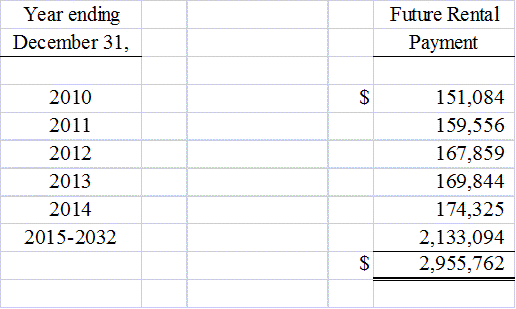
18
Pension and Employee Benefits
Full time employees of the PRC entities participate in a government mandated multi-employer
defined contribution plan pursuant to which certain pension benefits, medical care, unemployment
insurance, employee housing fund and other welfare benefits are provided to employees. Chinese
labor regulations require the Company to accrue for these benefits based on certain percentages of
the employees' salaries. The Management believes full time employees who have passed the
probation period are entitled to such benefits. The total provisions for such employee benefits was
$19,846 and $15,510 for the year ended December 31, 2009 and 2008, respectively.
Government Subsidies
The Company records government grants as current liabilities upon reception. A government
subsidy revenue is recognized only when there is reasonable assurance that the Company has
complied with all conditions attached to the grant. The Company recognized government subsidy of
$73,090 and $0 for the year ended December 31, 2009 and 2008, respecrively.
Income Taxes
The Company accounts for income tax in accordance with FASB ASC 740-10-25, which requires
the asset and liability approach for financial accounting and reporting for income taxes. Deferred
tax assets and liabilities are recognized for the future tax consequences attributable to differences
between the financial statement carrying amounts of existing assets and liabilities and their
respective tax bases. Deferred tax assets and liabilities are measured using enacted tax rates
expected to apply to taxable income in the years in which those temporary differences are expected
to be recovered or settled. The effect on deferred tax assets and liabilities of a change in tax rates is
recognized in income in the period that includes the enactment date. A valuation allowance related
to deferred tax assets is recorded when it is more likely than not that some portion or all of the
deferred tax assets will not be realized.
The Company has accumulated deficit in its operation. Because there is no certainty that we will
realize taxable income in the future, we did no record any deferred tax benefit as a result of these
losses.
Effective January 1, 2007, the Company adopted a new FASB guidance, which clarifies the
accounting for uncertainty in income taxes recognized in an enterprise’s financial statements. The
new FASB guidance prescribes a recognition threshold and measurement attribute for the financial
statement recognition and measurement of a tax position taken or expected to be taken in a tax
return. The new FASB guidance also provides guidance on de-recognition of tax benefits,
classification on the balance sheet, interest and penalties, accounting in interim periods, disclosure,
and transition. In accordance with the new FASB guidance, the Company performed a selfassessment
and concluded that there were no significant uncertain tax positions requiring recognition
in its consolidated financial statements.
19
Statutory Reserves
Pursuant to the applicable laws in PRC, PRC entities are required to make appropriations to three
non-distributable reserve funds, the statutory surplus reserve, statutory public welfare fund, and
discretionary surplus reserve, based on after-tax net earnings as determined in accordance with the
PRC GAAP, after offsetting any prior years’ losses. Appropriation to the statutory surplus reserve
should be at least 10% of the after-tax net earnings until the reserve is equal to 50% of the
Company's registered capital. Appropriation to the statutory public welfare fund is 5% to 10% of
the after-tax net earnings. The statutory public welfare fund is established for the purpose of
providing employee facilities and other collective benefits to the employees and is non-distributable
other than in liquidation. Beginning from January 1, 2006, enterprise is no more required to make
appropriation to the statutory public welfare fund. The Company does not make appropriations to
the discretionary surplus reserve fund.
Since the Company has been accumulating deficiency, no contribution has been made to statutory
surplus reserve fund and statutory public welfare reserve fund to date. The company will be required
to make contribution to the statutory surplus reserve fund and statutory public welfare reserve fund
upon the achievement of positive retained earnings, which means elimination of accumulated deficit
and making further positive net income.
Comprehensive Income
FASB guidance establishes standards for reporting and display of comprehensive income, its
components and accumulated balances. Comprehensive income as defined includes all changes in
equity during a period from non-owner sources. Accumulated comprehensive income, as presented
in the accompanying statements of changes in owners' equity consists of changes in unrealized gains
and losses on foreign currency translation. This comprehensive income is not included in the
computation of income tax expense or benefit.
Segment Reporting
FASB guidance establishes standards for reporting information about operating segments on a basis
consistent with the Company’s internal organization structure as well as information about
geographical areas, business segments and major customers in financial statements. The Company
currently operates in two principal business segments.
20
Earnings (Loss) Per Share
The Company reports earnings per share in accordance with FASB guidance, which requires
presentation of basic and diluted earnings per share in conjunction with the disclosure of the
methodology used in computing such earnings per share. Basic earnings (loss) per share is computed
by dividing income (loss) available to common shareholders by the weighted-average number of
common shares outstanding during the period. Diluted earnings per share is computed similar to basic
earnings per share except that the denominator is increased to include the number of additional
common shares that would have been outstanding if the potential common shares had been issued and
if the additional common shares were dilutive. There are no potentially dilutive securities outstanding
(options and warrants) for the years ended December 31, 2009 and 2008, respectively.
Fair Value Measures
Accounting principles generally accepted in the United States define fair value as the exchange price
that would be received for an asset or paid to transfer a liability (an exit price) in the principal or most
advantageous market for the asset or liability in an orderly transaction between market participants at
the measurement date. Additionally, the inputs used to measure fair value are prioritized based on a
three-level hierarchy. This hierarchy requires entities to maximize the use of observable inputs and
minimize the use of unobservable inputs. The three levels of inputs used to measure fair value are as
follows:
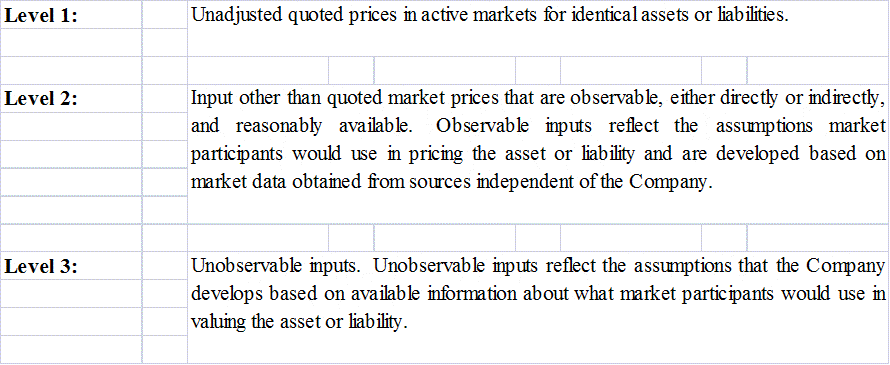
An asset or liability’s level within the fair value hierarchy is based on the lowest level of any input that
is significant to the fair value measurement. Availability of observable inputs can vary and is affected
by a variety of factors. The Company uses judgment in determining fair value of assets and liabilities
and Level 3 assets and liabilities involve greater judgment than Level 1 and Level 2 assets or liabilities.
21
Recent Accounting Pronouncements
In October 2009, the FASB issued ASU No. 2009-13, Multiple-Deliverable Revenue
Arrangements—a consensus of the FASB Emerging Issues Task Force, that provides amendments to
the criteria for separating consideration in multiple-deliverable arrangements. As a result of these
amendments, multiple-deliverable revenue arrangements will be separated in more circumstances than
under existing U.S. GAAP. The ASU does this by establishing a selling price hierarchy for
determining the selling price of a deliverable. The selling price used for each deliverable will be based
on vendor-specific objective evidence if available, third-party evidence if vendor-specific objective
evidence is not available, or estimated selling price if neither vendor-specific objective evidence nor
third-party evidence is available. A vendor will be required to determine its best estimate of selling
price in a manner that is consistent with that used to determine the price to sell the deliverable on a
standalone basis. This ASU also eliminates the residual method of allocation and will require that
arrangement consideration be allocated at the inception of the arrangement to all deliverables using the
relative selling price method, which allocates any discount in the overall arrangement proportionally to
each deliverable based on its relative selling price. Expanded disclosures of qualitative and quantitative
information regarding application of the multiple-deliverable revenue arrangement guidance are also
required under the ASU. The ASU does not apply to arrangements for which industry specific
allocation and measurement guidance exists, such as long-term construction contracts and software
transactions. The ASU is effective beginning January 1, 2011. We are currently evaluating the impact
of this standard on our financial position and results of operations.
In October 2009, the FASB issued ASU No. 2009-14, Certain Revenue Arrangements That Include
Software Elements—a consensus of the FASB Emerging Issues Task Force, that reduces the types of
transactions that fall within the current scope of software revenue recognition guidance. Existing
software revenue recognition guidance requires that its provisions be applied to an entire arrangement
when the sale of any products or services containing or utilizing software when the software is
considered more than incidental to the product or service. As a result of the amendments included in
ASU No. 2009-14, many tangible products and services that rely on software will be accounted for
under the multiple-element arrangements revenue recognition guidance rather than under the software
revenue recognition guidance. Under the ASU, the following components would be excluded from the
scope of software revenue recognition guidance: the tangible element of the product, software
products bundled with tangible products where the software components and non-software
components function together to deliver the product’s essential functionality, and undelivered
components that relate to software that is essential to the tangible product’s functionality. The ASU
also provides guidance on how to allocate transaction consideration when an arrangement contains
both deliverables within the scope of software revenue guidance (software deliverables) and
deliverables not within the scope of that guidance (non-software deliverables). The ASU is effective
beginning January 1, 2011. We are currently evaluating the impact of this standard on our financial
position and results of operations.
22
In December 2007, the FASB amended its guidance on accounting for business combinations. The
new accounting guidance resulted in a change in our accounting policy effective January 1, 2009, and
is being applied prospectively to all business combinations subsequent to the effective date. Among
other things, the new guidance amends the principles and requirements for how an acquirer recognizes
and measures in its financial statements the identifiable assets acquired, the liabilities assumed, any
noncontrolling interest in the acquiree and the goodwill acquired. It also establishes new disclosure
requirements to enable the evaluation of the nature and financial effects of the business combination.
The adoption of this new accounting policy did not have a significant impact on our consolidated
financial statements.
In December 2007, the FASB issued new accounting and disclosure guidance related to noncontrolling
interests in subsidiaries (previously referred to as "minority interests"), which resulted in a change in
our accounting policy effective January 1, 2009. Among other things, the new guidance requires that a
noncontrolling interest in a subsidiary be accounted for as a component of equity separate from the
parent's equity, rather than as a liability. The new guidance is being applied prospectively, except for
the presentation and disclosure requirements, which have been applied retrospectively. The adoption of
this new accounting policy did not have a significant impact on our consolidated financial statements
In December 2007, the FASB issued new accounting guidance that defines collaborative arrangements
and establishes reporting requirements for transactions between participants in a collaborative
arrangement and between participants in the arrangement and third parties. It also establishes the
appropriate income statement presentation and classification for joint operating activities and payments
between participants, as well as the sufficiency of the disclosures related to those arrangements. This
new accounting guidance was effective for our Company on January 1, 2009, and its adoption did not
have a significant impact on our consolidated financial statements.
In February 2007, the FASB issued new accounting guidance that permits entities to choose to
measure many financial instruments and certain other items at fair value. Unrealized gains and losses
on items for which the fair value option has been elected will be recognized in earnings at each
subsequent reporting date. This new accounting guidance was effective for our Company on January 1,
2008. The Company did not elect the fair value option for any financial instruments or other items
permitted under this guidance; therefore, its adoption had no impact on our consolidated financial
statements.
In September 2006, the FASB issued new accounting guidance that defines fair value, establishes a
framework for measuring fair value, and expands disclosure requirements about fair value
measurements. However, in February 2008, the FASB delayed the effective date of the new accounting
guidance for all nonfinancial assets and nonfinancial liabilities, except those that are recognized or
disclosed at fair value in the financial statements on a recurring basis (at least annually), until January
1, 2009. The accounting guidance related to recurring fair value measurements was effective for our
Company on January 1, 2008. The adoption of this accounting guidance did not have a significant
impact on our consolidated financial statements.
23
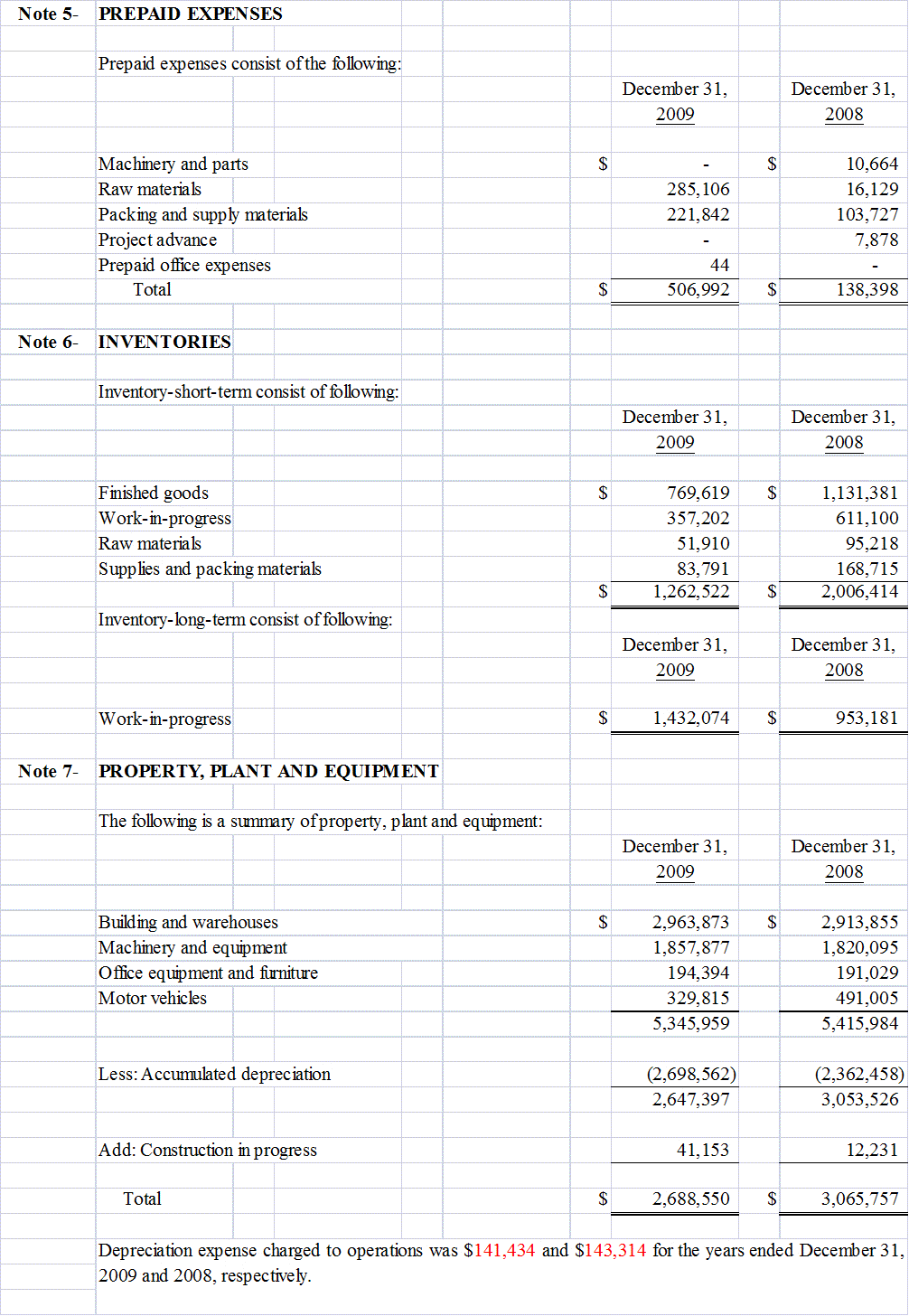

25
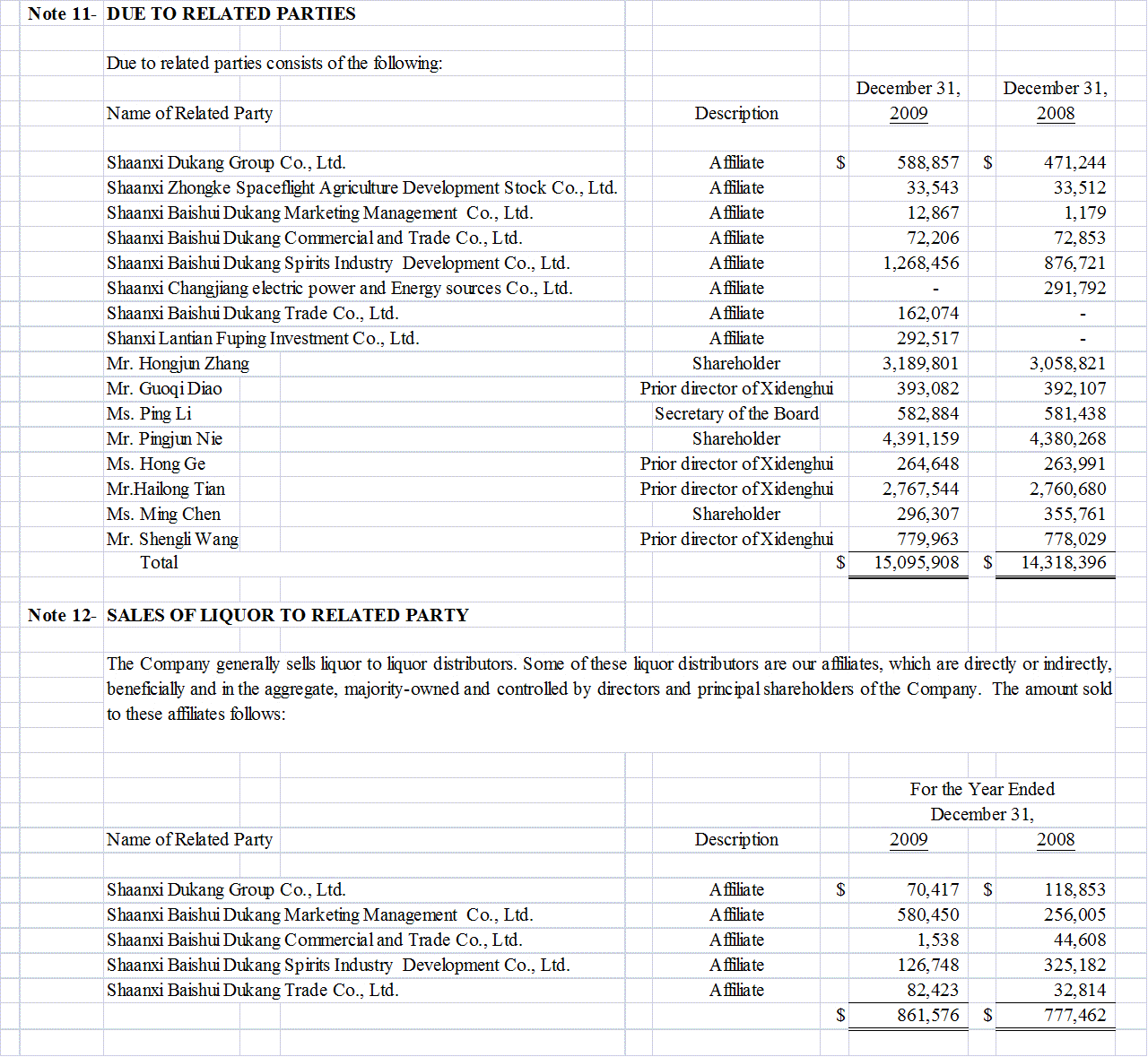
26
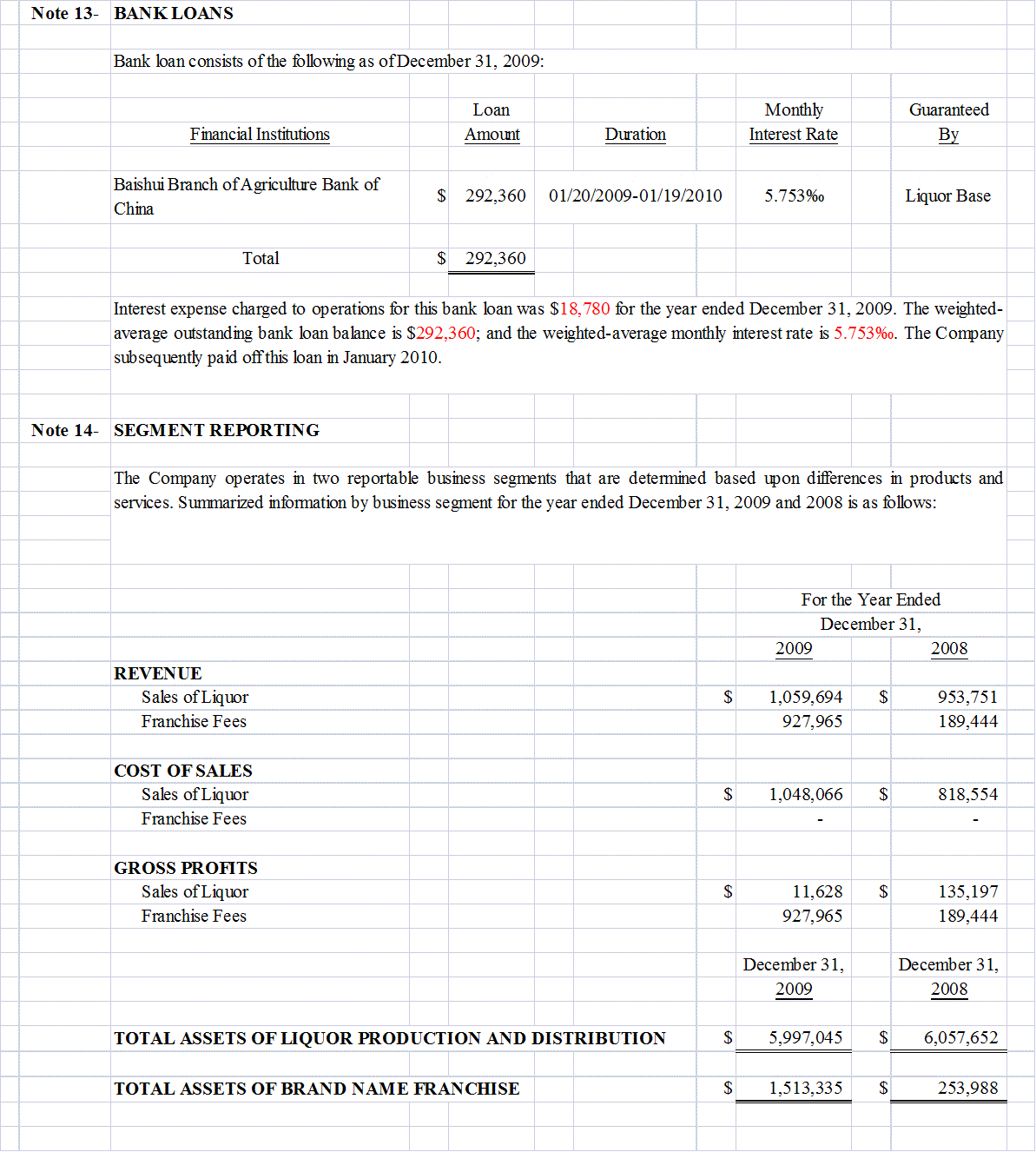
27
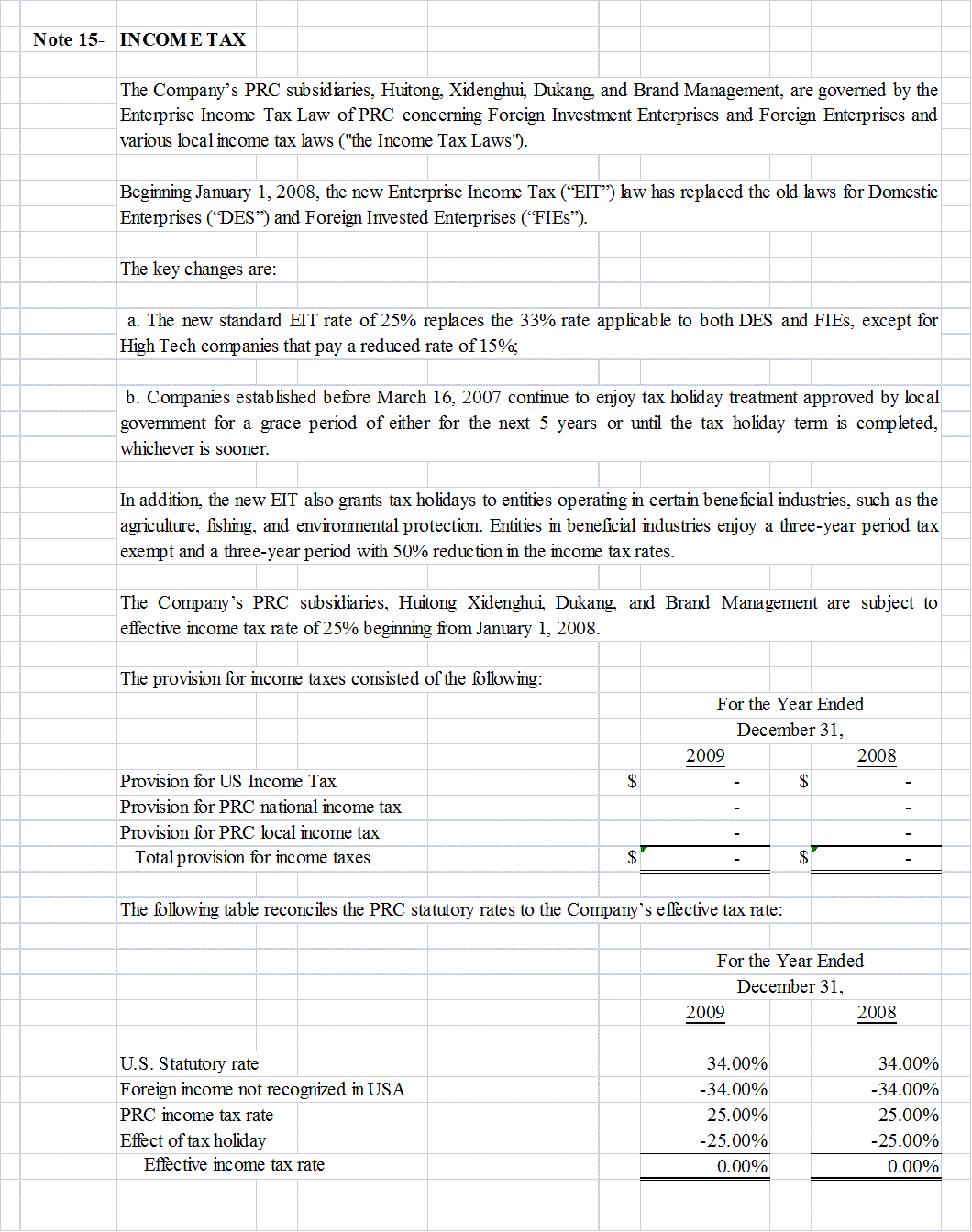
28
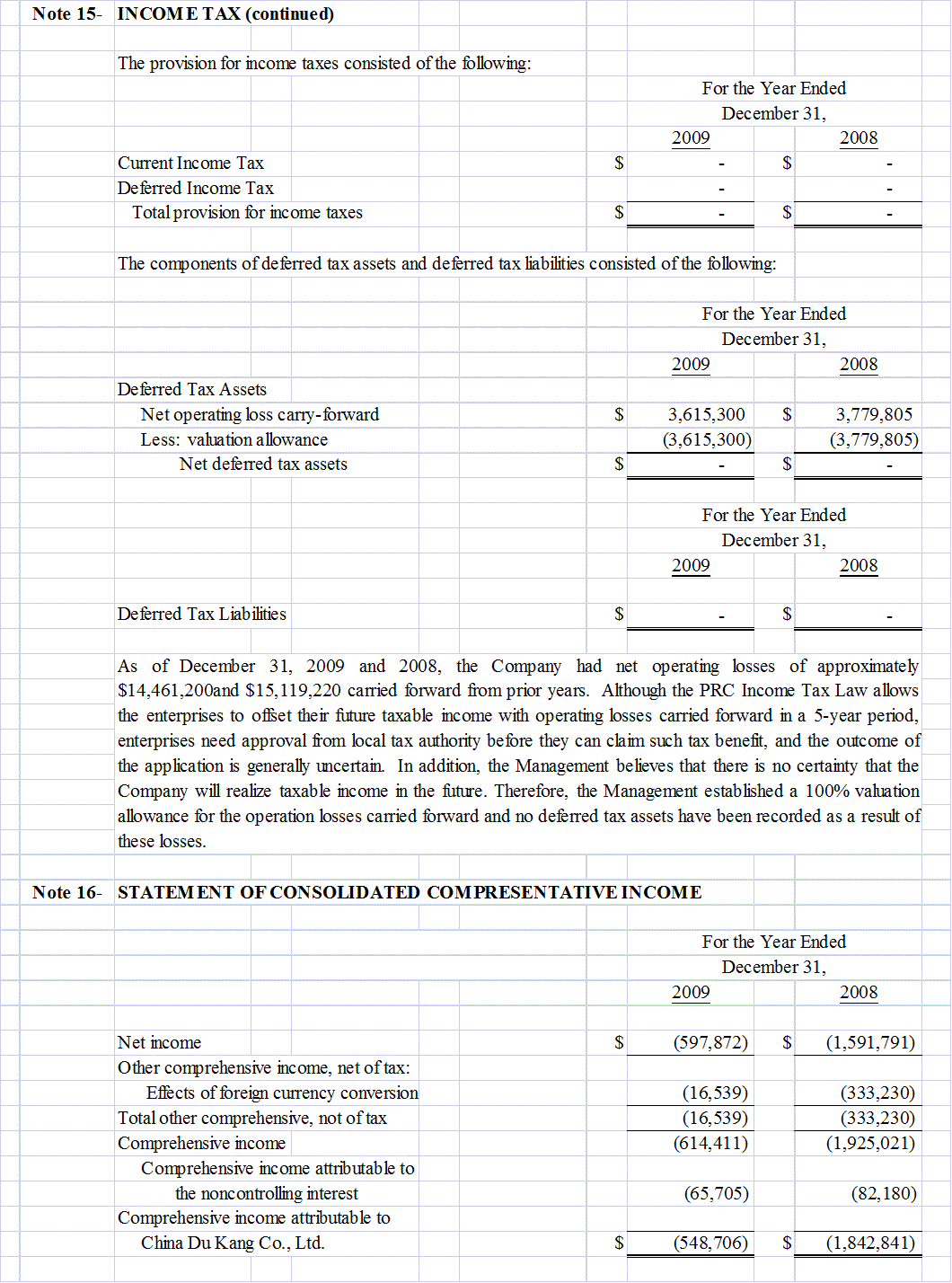

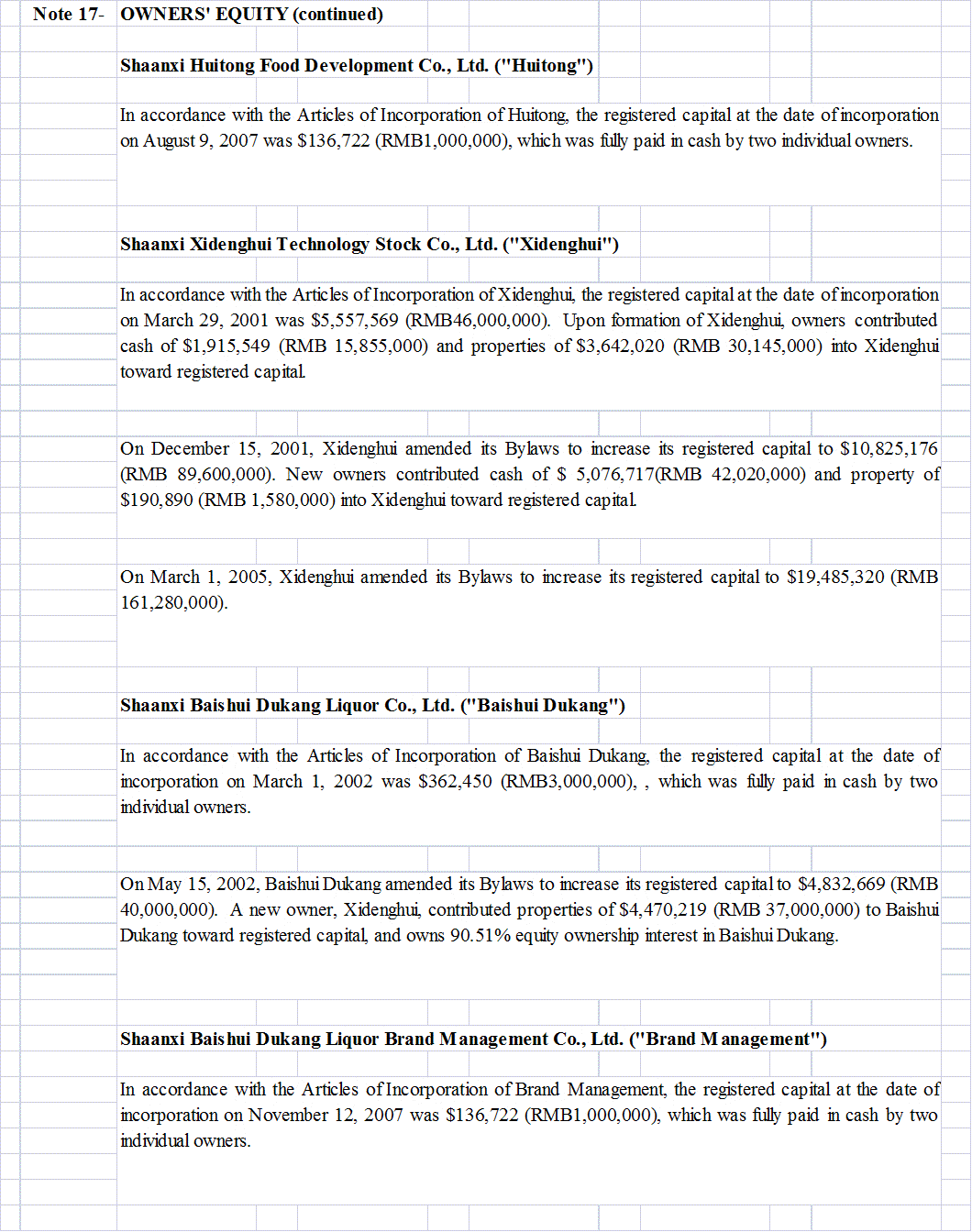
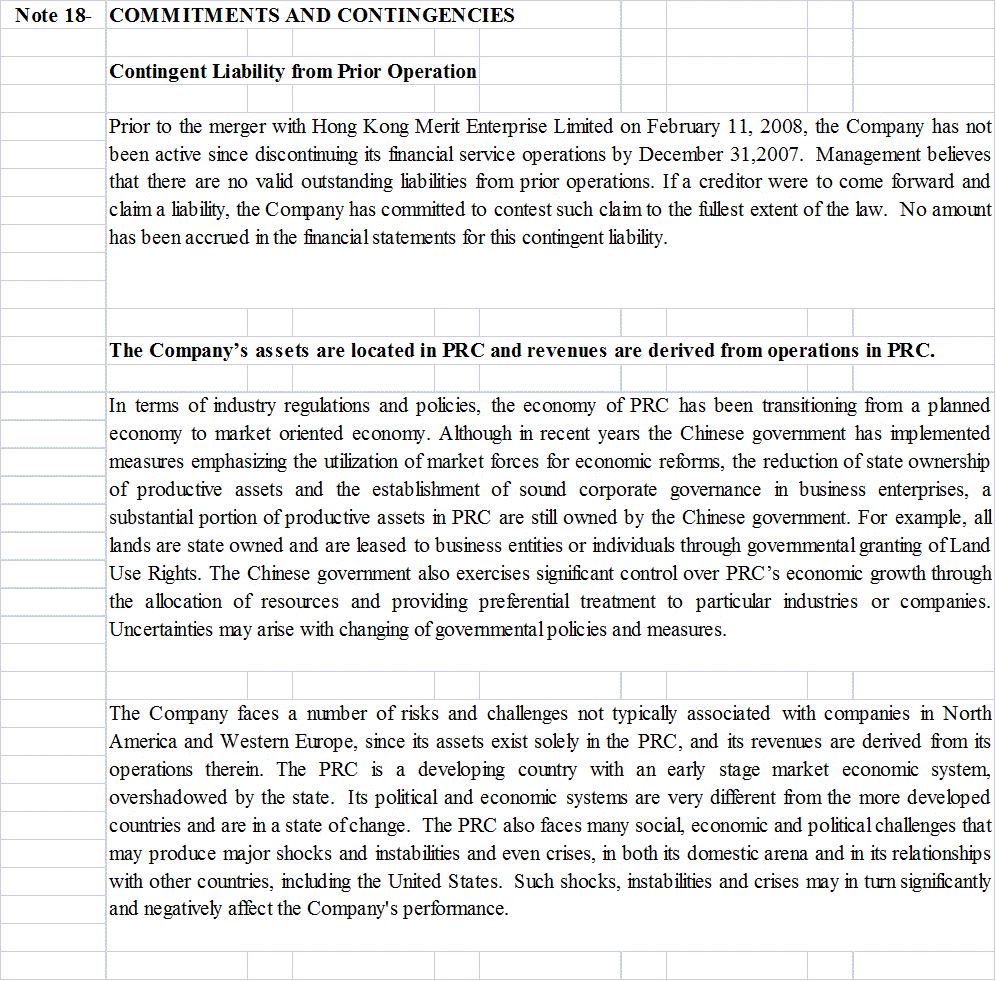
ITEM 9. CHANGES IN AND DISAGREEMENTS WITH ACCOUNTANTS ON ACCOUNTING AND FINANCIAL DISCLOSURE.
We have had no change in our principal accountant during the period for which disclosure is required under Section 304 of Regulation S-K and have had no disagreements with our auditor. Our auditor is Keith K. Zhen, Certified Public Accountant, 2070 West 6th Street, Brooklyn, NY 11223.
ITEM 9A. CONTROLS AND PROCEDURES
Not Required.
ITEM 9A(T). CONTROLS AND PROCEDURES
Not Required.
ITEM 9B. OTHER INFORMATION
None.
ITEM 10. DIRECTORS, EXECUTIVE OFFICERS, PROMOTERS AND CONTROL PERSONS; COMPLIANCE WITH SECTION 16(A) OF THE EXCHANGE ACT



























